Quanta Computer 145015318 Notebook PC with Integrated Wireless LAN User Manual Using Your Solo 1450
Quanta Computer Inc Notebook PC with Integrated Wireless LAN Using Your Solo 1450
Users Manual Part 1
i
Contents
1 Checking Out Your Gateway Solo 1450. . . . . . . . . . . . . . . . . . . . . . . . . . 1
Front . . . . . . . . . . . . . . . . . . . . . . . . . . . . . . . . . . . . . . . . . . . . . . . . . . . . . . . . . . . . . 2
Left side . . . . . . . . . . . . . . . . . . . . . . . . . . . . . . . . . . . . . . . . . . . . . . . . . . . . . . . . . . . 3
Right side . . . . . . . . . . . . . . . . . . . . . . . . . . . . . . . . . . . . . . . . . . . . . . . . . . . . . . . . . . 4
Back . . . . . . . . . . . . . . . . . . . . . . . . . . . . . . . . . . . . . . . . . . . . . . . . . . . . . . . . . . . . . . 5
Bottom . . . . . . . . . . . . . . . . . . . . . . . . . . . . . . . . . . . . . . . . . . . . . . . . . . . . . . . . . . . . 6
Keyboard area . . . . . . . . . . . . . . . . . . . . . . . . . . . . . . . . . . . . . . . . . . . . . . . . . . . . . . 7
Identifying your model . . . . . . . . . . . . . . . . . . . . . . . . . . . . . . . . . . . . . . . . . . . . . . . . 9
Accessories . . . . . . . . . . . . . . . . . . . . . . . . . . . . . . . . . . . . . . . . . . . . . . . . . . . . . . . 10
2Getting Started. . . . . . . . . . . . . . . . . . . . . . . . . . . . . . . . . . . . . . . . . . . . . . . . . . 11
Connecting the AC adapter . . . . . . . . . . . . . . . . . . . . . . . . . . . . . . . . . . . . . . . . . . . 12
Protecting from power source problems . . . . . . . . . . . . . . . . . . . . . . . . . . . . . . 14
Starting your notebook . . . . . . . . . . . . . . . . . . . . . . . . . . . . . . . . . . . . . . . . . . . . . . 15
Waking up your notebook . . . . . . . . . . . . . . . . . . . . . . . . . . . . . . . . . . . . . . . . . 15
Turning off your notebook . . . . . . . . . . . . . . . . . . . . . . . . . . . . . . . . . . . . . . . . . . . . 16
Status indicators . . . . . . . . . . . . . . . . . . . . . . . . . . . . . . . . . . . . . . . . . . . . . . . . . . . 17
Using the keyboard . . . . . . . . . . . . . . . . . . . . . . . . . . . . . . . . . . . . . . . . . . . . . . . . . 18
Key types . . . . . . . . . . . . . . . . . . . . . . . . . . . . . . . . . . . . . . . . . . . . . . . . . . . . . 19
System key combinations . . . . . . . . . . . . . . . . . . . . . . . . . . . . . . . . . . . . . . . . . 20
Multi-function buttons . . . . . . . . . . . . . . . . . . . . . . . . . . . . . . . . . . . . . . . . . . . . . . . 22
Using the EZ Pad touchpad . . . . . . . . . . . . . . . . . . . . . . . . . . . . . . . . . . . . . . . . . . 23
Using the touchpad . . . . . . . . . . . . . . . . . . . . . . . . . . . . . . . . . . . . . . . . . . . . . . 24
Connecting the modem . . . . . . . . . . . . . . . . . . . . . . . . . . . . . . . . . . . . . . . . . . . . . . 26
Connecting to an Ethernet network . . . . . . . . . . . . . . . . . . . . . . . . . . . . . . . . . . . . 27
Broadband Internet connections . . . . . . . . . . . . . . . . . . . . . . . . . . . . . . . . . . . . 27
Installing a printer, scanner, or other peripheral device . . . . . . . . . . . . . . . . . . . . . 28
3Getting Help . . . . . . . . . . . . . . . . . . . . . . . . . . . . . . . . . . . . . . . . . . . . . . . . . . . . 29
HelpSpot . . . . . . . . . . . . . . . . . . . . . . . . . . . . . . . . . . . . . . . . . . . . . . . . . . . . . . . . . 30
HelpSpot Videos . . . . . . . . . . . . . . . . . . . . . . . . . . . . . . . . . . . . . . . . . . . . . . . . 32
Online help . . . . . . . . . . . . . . . . . . . . . . . . . . . . . . . . . . . . . . . . . . . . . . . . . . . . . . . 33
Gateway Web site . . . . . . . . . . . . . . . . . . . . . . . . . . . . . . . . . . . . . . . . . . . . . . . . . . 34
4 Windows Basics . . . . . . . . . . . . . . . . . . . . . . . . . . . . . . . . . . . . . . . . . . . . . . . . 35
About the Windows environment . . . . . . . . . . . . . . . . . . . . . . . . . . . . . . . . . . . . . . 36
Using the desktop . . . . . . . . . . . . . . . . . . . . . . . . . . . . . . . . . . . . . . . . . . . . . . . . . . 37
Using the Start menu . . . . . . . . . . . . . . . . . . . . . . . . . . . . . . . . . . . . . . . . . . . . 38
Identifying Window items . . . . . . . . . . . . . . . . . . . . . . . . . . . . . . . . . . . . . . . . . . . . . 39
ii
Working with files and folders . . . . . . . . . . . . . . . . . . . . . . . . . . . . . . . . . . . . . . . . .41
Viewing drives . . . . . . . . . . . . . . . . . . . . . . . . . . . . . . . . . . . . . . . . . . . . . . . . . .41
Creating folders . . . . . . . . . . . . . . . . . . . . . . . . . . . . . . . . . . . . . . . . . . . . . . . . .42
Copying and moving files and folders . . . . . . . . . . . . . . . . . . . . . . . . . . . . . . . .43
Deleting files and folders . . . . . . . . . . . . . . . . . . . . . . . . . . . . . . . . . . . . . . . . . .45
Browsing for files and folders . . . . . . . . . . . . . . . . . . . . . . . . . . . . . . . . . . . . . .47
Searching for files . . . . . . . . . . . . . . . . . . . . . . . . . . . . . . . . . . . . . . . . . . . . . . . . . . .48
Using the Search utility . . . . . . . . . . . . . . . . . . . . . . . . . . . . . . . . . . . . . . . . . . .49
Working with documents . . . . . . . . . . . . . . . . . . . . . . . . . . . . . . . . . . . . . . . . . . . . .51
Creating a new document . . . . . . . . . . . . . . . . . . . . . . . . . . . . . . . . . . . . . . . . .51
Saving a document . . . . . . . . . . . . . . . . . . . . . . . . . . . . . . . . . . . . . . . . . . . . . .52
Opening a document . . . . . . . . . . . . . . . . . . . . . . . . . . . . . . . . . . . . . . . . . . . . .53
Printing a document . . . . . . . . . . . . . . . . . . . . . . . . . . . . . . . . . . . . . . . . . . . . . .54
Shortcuts . . . . . . . . . . . . . . . . . . . . . . . . . . . . . . . . . . . . . . . . . . . . . . . . . . . . . . . . . .55
5 Using the Internet . . . . . . . . . . . . . . . . . . . . . . . . . . . . . . . . . . . . . . . . . . . . . . .57
Learning about the Internet . . . . . . . . . . . . . . . . . . . . . . . . . . . . . . . . . . . . . . . . . . .58
Setting up an Internet account . . . . . . . . . . . . . . . . . . . . . . . . . . . . . . . . . . . . . . . . .59
Accessing your Internet account . . . . . . . . . . . . . . . . . . . . . . . . . . . . . . . . . . . .60
Using the World Wide Web . . . . . . . . . . . . . . . . . . . . . . . . . . . . . . . . . . . . . . . . . . .61
Connecting to a Web site . . . . . . . . . . . . . . . . . . . . . . . . . . . . . . . . . . . . . . . . . .62
Downloading files . . . . . . . . . . . . . . . . . . . . . . . . . . . . . . . . . . . . . . . . . . . . . . . .63
Using e-mail . . . . . . . . . . . . . . . . . . . . . . . . . . . . . . . . . . . . . . . . . . . . . . . . . . . . . . .64
Sending e-mail . . . . . . . . . . . . . . . . . . . . . . . . . . . . . . . . . . . . . . . . . . . . . . . . . .65
Checking your e-mail . . . . . . . . . . . . . . . . . . . . . . . . . . . . . . . . . . . . . . . . . . . . .65
6 Using Multimedia . . . . . . . . . . . . . . . . . . . . . . . . . . . . . . . . . . . . . . . . . . . . . . . .67
Using diskettes . . . . . . . . . . . . . . . . . . . . . . . . . . . . . . . . . . . . . . . . . . . . . . . . . . . . .68
Using a CD, CD-RW, or DVD drive . . . . . . . . . . . . . . . . . . . . . . . . . . . . . . . . . . . . .69
Inserting a CD, CD-RW, or DVD . . . . . . . . . . . . . . . . . . . . . . . . . . . . . . . . . . . .69
Creating CDs using your CD-RW or DVD/CD-RW drive . . . . . . . . . . . . . . . . . . . . .70
Creating data CDs . . . . . . . . . . . . . . . . . . . . . . . . . . . . . . . . . . . . . . . . . . . . . . .70
Creating music CDs . . . . . . . . . . . . . . . . . . . . . . . . . . . . . . . . . . . . . . . . . . . . . .73
Adjusting the volume . . . . . . . . . . . . . . . . . . . . . . . . . . . . . . . . . . . . . . . . . . . . . . . .77
Listening to CDs . . . . . . . . . . . . . . . . . . . . . . . . . . . . . . . . . . . . . . . . . . . . . . . . . . . .80
Recording and playing audio . . . . . . . . . . . . . . . . . . . . . . . . . . . . . . . . . . . . . . . . . .81
Playing audio and video files with the Windows Media Player . . . . . . . . . . . . .83
Playing a DVD . . . . . . . . . . . . . . . . . . . . . . . . . . . . . . . . . . . . . . . . . . . . . . . . . .84
Using MusicMatch . . . . . . . . . . . . . . . . . . . . . . . . . . . . . . . . . . . . . . . . . . . . . . . . . .85
Playing CDs . . . . . . . . . . . . . . . . . . . . . . . . . . . . . . . . . . . . . . . . . . . . . . . . . . . .85
Creating music files . . . . . . . . . . . . . . . . . . . . . . . . . . . . . . . . . . . . . . . . . . . . . .86
Editing track information . . . . . . . . . . . . . . . . . . . . . . . . . . . . . . . . . . . . . . . . . . .88
Building a music library . . . . . . . . . . . . . . . . . . . . . . . . . . . . . . . . . . . . . . . . . . .89
iii
Listening to Internet radio . . . . . . . . . . . . . . . . . . . . . . . . . . . . . . . . . . . . . . . . . 91
Using advanced features . . . . . . . . . . . . . . . . . . . . . . . . . . . . . . . . . . . . . . . . . 92
7 Sending and Receiving Faxes . . . . . . . . . . . . . . . . . . . . . . . . . . . . . . . . . . 93
Setting up your cover page . . . . . . . . . . . . . . . . . . . . . . . . . . . . . . . . . . . . . . . . . . . 94
Sending a fax . . . . . . . . . . . . . . . . . . . . . . . . . . . . . . . . . . . . . . . . . . . . . . . . . . . . . 96
Faxing from programs . . . . . . . . . . . . . . . . . . . . . . . . . . . . . . . . . . . . . . . . . . . . . . . 98
Receiving and viewing a fax . . . . . . . . . . . . . . . . . . . . . . . . . . . . . . . . . . . . . . . . . . 98
8 Managing Power . . . . . . . . . . . . . . . . . . . . . . . . . . . . . . . . . . . . . . . . . . . . . . . . 99
Monitoring the battery charge . . . . . . . . . . . . . . . . . . . . . . . . . . . . . . . . . . . . . . . . 100
Recharging the battery . . . . . . . . . . . . . . . . . . . . . . . . . . . . . . . . . . . . . . . . . . . . . 101
Recalibrating the battery . . . . . . . . . . . . . . . . . . . . . . . . . . . . . . . . . . . . . . . . . . . . 102
Changing batteries . . . . . . . . . . . . . . . . . . . . . . . . . . . . . . . . . . . . . . . . . . . . . . . . 103
Extending battery life . . . . . . . . . . . . . . . . . . . . . . . . . . . . . . . . . . . . . . . . . . . . . . . 105
Conserving battery power . . . . . . . . . . . . . . . . . . . . . . . . . . . . . . . . . . . . . . . . 105
Using alternate power sources . . . . . . . . . . . . . . . . . . . . . . . . . . . . . . . . . . . . 105
Changing power modes . . . . . . . . . . . . . . . . . . . . . . . . . . . . . . . . . . . . . . . . . 106
Changing power settings . . . . . . . . . . . . . . . . . . . . . . . . . . . . . . . . . . . . . . . . . . . . 107
Changing the power scheme . . . . . . . . . . . . . . . . . . . . . . . . . . . . . . . . . . . . . 108
Changing alarm options . . . . . . . . . . . . . . . . . . . . . . . . . . . . . . . . . . . . . . . . . 109
Changing advanced settings . . . . . . . . . . . . . . . . . . . . . . . . . . . . . . . . . . . . . 110
Activating and Using Hibernate Mode . . . . . . . . . . . . . . . . . . . . . . . . . . . . . . 111
Changing SpeedStep settings . . . . . . . . . . . . . . . . . . . . . . . . . . . . . . . . . . . . 112
9Travel tips . . . . . . . . . . . . . . . . . . . . . . . . . . . . . . . . . . . . . . . . . . . . . . . . . . . . . 113
Modem . . . . . . . . . . . . . . . . . . . . . . . . . . . . . . . . . . . . . . . . . . . . . . . . . . . . . . . . . . 114
Radio frequency wireless connections . . . . . . . . . . . . . . . . . . . . . . . . . . . . . . . . . 114
Files . . . . . . . . . . . . . . . . . . . . . . . . . . . . . . . . . . . . . . . . . . . . . . . . . . . . . . . . . . . . 115
Security . . . . . . . . . . . . . . . . . . . . . . . . . . . . . . . . . . . . . . . . . . . . . . . . . . . . . . . . . 115
Power . . . . . . . . . . . . . . . . . . . . . . . . . . . . . . . . . . . . . . . . . . . . . . . . . . . . . . . . . . . 116
10 Customizing Your Notebook . . . . . . . . . . . . . . . . . . . . . . . . . . . . . . . . . . . 117
Adjusting the screen and desktop settings . . . . . . . . . . . . . . . . . . . . . . . . . . . . . . 118
Adjusting the color depth . . . . . . . . . . . . . . . . . . . . . . . . . . . . . . . . . . . . . . . . 118
Adjusting the screen resolution . . . . . . . . . . . . . . . . . . . . . . . . . . . . . . . . . . . 120
Applying a color scheme . . . . . . . . . . . . . . . . . . . . . . . . . . . . . . . . . . . . . . . . 121
Changing the desktop background . . . . . . . . . . . . . . . . . . . . . . . . . . . . . . . . . 122
Selecting a screen saver . . . . . . . . . . . . . . . . . . . . . . . . . . . . . . . . . . . . . . . . 123
Changing the touchpad settings . . . . . . . . . . . . . . . . . . . . . . . . . . . . . . . . . . . . . . 125
Programming the multi-function buttons . . . . . . . . . . . . . . . . . . . . . . . . . . . . . . . . 126
Adding and modifying user accounts . . . . . . . . . . . . . . . . . . . . . . . . . . . . . . . . . . 127
iv
11 Upgrading Your Notebook. . . . . . . . . . . . . . . . . . . . . . . . . . . . . . . . . . . . . .129
Adding PC Cards . . . . . . . . . . . . . . . . . . . . . . . . . . . . . . . . . . . . . . . . . . . . . . . . . .130
Preventing static electricity discharge . . . . . . . . . . . . . . . . . . . . . . . . . . . . . . . . . .132
Installing memory . . . . . . . . . . . . . . . . . . . . . . . . . . . . . . . . . . . . . . . . . . . . . . . . . .133
Replacing the hard drive . . . . . . . . . . . . . . . . . . . . . . . . . . . . . . . . . . . . . . . . . . . .137
12 Networking Your Notebook. . . . . . . . . . . . . . . . . . . . . . . . . . . . . . . . . . . . .139
The benefits of using a network . . . . . . . . . . . . . . . . . . . . . . . . . . . . . . . . . . . . . . .140
Sharing a single Internet connection . . . . . . . . . . . . . . . . . . . . . . . . . . . . . . . .140
Sharing drives . . . . . . . . . . . . . . . . . . . . . . . . . . . . . . . . . . . . . . . . . . . . . . . . .140
Sharing peripheral devices . . . . . . . . . . . . . . . . . . . . . . . . . . . . . . . . . . . . . . . .140
Streaming audio and video files . . . . . . . . . . . . . . . . . . . . . . . . . . . . . . . . . . .141
Playing multi-player games . . . . . . . . . . . . . . . . . . . . . . . . . . . . . . . . . . . . . . .141
Example network . . . . . . . . . . . . . . . . . . . . . . . . . . . . . . . . . . . . . . . . . . . . . . . . . .142
Selecting a network connection . . . . . . . . . . . . . . . . . . . . . . . . . . . . . . . . . . . . . . .143
Wired connections . . . . . . . . . . . . . . . . . . . . . . . . . . . . . . . . . . . . . . . . . . . . . .143
Wireless Connections . . . . . . . . . . . . . . . . . . . . . . . . . . . . . . . . . . . . . . . . . . . .144
Assessing your connection needs . . . . . . . . . . . . . . . . . . . . . . . . . . . . . . . . . .145
Comparing data transfer speed . . . . . . . . . . . . . . . . . . . . . . . . . . . . . . . . . . . .146
Using a wireless network . . . . . . . . . . . . . . . . . . . . . . . . . . . . . . . . . . . . . . . . . . . .148
Using wireless Ethernet . . . . . . . . . . . . . . . . . . . . . . . . . . . . . . . . . . . . . . . . . .149
Purchasing additional network equipment . . . . . . . . . . . . . . . . . . . . . . . . . . . . . . .174
HPNA . . . . . . . . . . . . . . . . . . . . . . . . . . . . . . . . . . . . . . . . . . . . . . . . . . . . . . . .174
Ethernet . . . . . . . . . . . . . . . . . . . . . . . . . . . . . . . . . . . . . . . . . . . . . . . . . . . . . .175
Wireless Ethernet . . . . . . . . . . . . . . . . . . . . . . . . . . . . . . . . . . . . . . . . . . . . . . .176
For more information . . . . . . . . . . . . . . . . . . . . . . . . . . . . . . . . . . . . . . . . . . . . . . .176
13 Moving From Your Old Computer . . . . . . . . . . . . . . . . . . . . . . . . . . . . . .177
Transferring software and hardware from your old computer . . . . . . . . . . . . . . . .177
Using the Windows XP Files and Settings Transfer Wizard . . . . . . . . . . . . . .177
Transferring files . . . . . . . . . . . . . . . . . . . . . . . . . . . . . . . . . . . . . . . . . . . . . . . .178
Transferring Internet settings . . . . . . . . . . . . . . . . . . . . . . . . . . . . . . . . . . . . . .179
Reinstalling your old printer or scanner . . . . . . . . . . . . . . . . . . . . . . . . . . . . . .180
Reinstalling your old programs . . . . . . . . . . . . . . . . . . . . . . . . . . . . . . . . . . . .181
14 Maintaining Your Notebook. . . . . . . . . . . . . . . . . . . . . . . . . . . . . . . . . . . . .183
Caring for your computer . . . . . . . . . . . . . . . . . . . . . . . . . . . . . . . . . . . . . . . . . . . .183
Creating an emergency startup diskette . . . . . . . . . . . . . . . . . . . . . . . . . . . . . . . .185
Protecting your computer from viruses . . . . . . . . . . . . . . . . . . . . . . . . . . . . . . . . .187
Managing hard drive space . . . . . . . . . . . . . . . . . . . . . . . . . . . . . . . . . . . . . . . . . .189
Checking hard drive space . . . . . . . . . . . . . . . . . . . . . . . . . . . . . . . . . . . . . . .189
Using Disk Cleanup . . . . . . . . . . . . . . . . . . . . . . . . . . . . . . . . . . . . . . . . . . . . .190
v
Checking the hard drive for errors . . . . . . . . . . . . . . . . . . . . . . . . . . . . . . . . . 191
Defragmenting the hard drive . . . . . . . . . . . . . . . . . . . . . . . . . . . . . . . . . . . . . 193
Backing up files . . . . . . . . . . . . . . . . . . . . . . . . . . . . . . . . . . . . . . . . . . . . . . . . 195
Using the Scheduled Task Wizard . . . . . . . . . . . . . . . . . . . . . . . . . . . . . . . . . 196
Cleaning your computer . . . . . . . . . . . . . . . . . . . . . . . . . . . . . . . . . . . . . . . . . . . . 197
Cleaning the exterior . . . . . . . . . . . . . . . . . . . . . . . . . . . . . . . . . . . . . . . . . . . . 197
Cleaning the keyboard . . . . . . . . . . . . . . . . . . . . . . . . . . . . . . . . . . . . . . . . . . 198
Cleaning the screen . . . . . . . . . . . . . . . . . . . . . . . . . . . . . . . . . . . . . . . . . . . . 198
Cleaning the mouse . . . . . . . . . . . . . . . . . . . . . . . . . . . . . . . . . . . . . . . . . . . . 198
15 Restoring Software . . . . . . . . . . . . . . . . . . . . . . . . . . . . . . . . . . . . . . . . . . . . 201
Using the Restoration CDs . . . . . . . . . . . . . . . . . . . . . . . . . . . . . . . . . . . . . . . . . . 201
Reinstalling device drivers . . . . . . . . . . . . . . . . . . . . . . . . . . . . . . . . . . . . . . . . . . . 202
Updating device drivers . . . . . . . . . . . . . . . . . . . . . . . . . . . . . . . . . . . . . . . . . . . . . 204
Reinstalling programs . . . . . . . . . . . . . . . . . . . . . . . . . . . . . . . . . . . . . . . . . . . . . . 206
Reinstalling Windows . . . . . . . . . . . . . . . . . . . . . . . . . . . . . . . . . . . . . . . . . . . . . . 208
16 Troubleshooting . . . . . . . . . . . . . . . . . . . . . . . . . . . . . . . . . . . . . . . . . . . . . . . 211
Safety guidelines . . . . . . . . . . . . . . . . . . . . . . . . . . . . . . . . . . . . . . . . . . . . . . . . . . 212
First steps . . . . . . . . . . . . . . . . . . . . . . . . . . . . . . . . . . . . . . . . . . . . . . . . . . . . . . . 213
Software support tools . . . . . . . . . . . . . . . . . . . . . . . . . . . . . . . . . . . . . . . . . . . . . . 214
Troubleshooting . . . . . . . . . . . . . . . . . . . . . . . . . . . . . . . . . . . . . . . . . . . . . . . . . . . 215
CD, CD-RW, DVD, or DVD/CD-RW drives . . . . . . . . . . . . . . . . . . . . . . . . . . 215
Device installation . . . . . . . . . . . . . . . . . . . . . . . . . . . . . . . . . . . . . . . . . . . . . . 217
Diskette drive . . . . . . . . . . . . . . . . . . . . . . . . . . . . . . . . . . . . . . . . . . . . . . . . . 217
File management . . . . . . . . . . . . . . . . . . . . . . . . . . . . . . . . . . . . . . . . . . . . . . 218
Hard drive . . . . . . . . . . . . . . . . . . . . . . . . . . . . . . . . . . . . . . . . . . . . . . . . . . . . 219
Internet . . . . . . . . . . . . . . . . . . . . . . . . . . . . . . . . . . . . . . . . . . . . . . . . . . . . . . 219
Keyboard . . . . . . . . . . . . . . . . . . . . . . . . . . . . . . . . . . . . . . . . . . . . . . . . . . . . . 221
LCD panel . . . . . . . . . . . . . . . . . . . . . . . . . . . . . . . . . . . . . . . . . . . . . . . . . . . . 221
Memory . . . . . . . . . . . . . . . . . . . . . . . . . . . . . . . . . . . . . . . . . . . . . . . . . . . . . . 222
Modem . . . . . . . . . . . . . . . . . . . . . . . . . . . . . . . . . . . . . . . . . . . . . . . . . . . . . . 222
Mouse . . . . . . . . . . . . . . . . . . . . . . . . . . . . . . . . . . . . . . . . . . . . . . . . . . . . . . . 226
Networks . . . . . . . . . . . . . . . . . . . . . . . . . . . . . . . . . . . . . . . . . . . . . . . . . . . . . 226
Passwords . . . . . . . . . . . . . . . . . . . . . . . . . . . . . . . . . . . . . . . . . . . . . . . . . . . . 226
PC Cards . . . . . . . . . . . . . . . . . . . . . . . . . . . . . . . . . . . . . . . . . . . . . . . . . . . . . 226
Power . . . . . . . . . . . . . . . . . . . . . . . . . . . . . . . . . . . . . . . . . . . . . . . . . . . . . . . 227
Printer . . . . . . . . . . . . . . . . . . . . . . . . . . . . . . . . . . . . . . . . . . . . . . . . . . . . . . . 227
Sound . . . . . . . . . . . . . . . . . . . . . . . . . . . . . . . . . . . . . . . . . . . . . . . . . . . . . . . 229
Video . . . . . . . . . . . . . . . . . . . . . . . . . . . . . . . . . . . . . . . . . . . . . . . . . . . . . . . . 229
Telephone support . . . . . . . . . . . . . . . . . . . . . . . . . . . . . . . . . . . . . . . . . . . . . . . . . 230
Before calling Gateway Technical Support . . . . . . . . . . . . . . . . . . . . . . . . . . 230
Telephone numbers . . . . . . . . . . . . . . . . . . . . . . . . . . . . . . . . . . . . . . . . . . . . 231
vi
Tutoring and training . . . . . . . . . . . . . . . . . . . . . . . . . . . . . . . . . . . . . . . . . . . . . . . .232
Self-help . . . . . . . . . . . . . . . . . . . . . . . . . . . . . . . . . . . . . . . . . . . . . . . . . . . . . .232
Tutoring . . . . . . . . . . . . . . . . . . . . . . . . . . . . . . . . . . . . . . . . . . . . . . . . . . . . . .232
Training . . . . . . . . . . . . . . . . . . . . . . . . . . . . . . . . . . . . . . . . . . . . . . . . . . . . . . .232
A Safety, Regulatory, and Legal Information. . . . . . . . . . . . . . . . . . . . . .235
Index. . . . . . . . . . . . . . . . . . . . . . . . . . . . . . . . . . . . . . . . . . . . . . . . . . . . . . . . . . . . . . 253
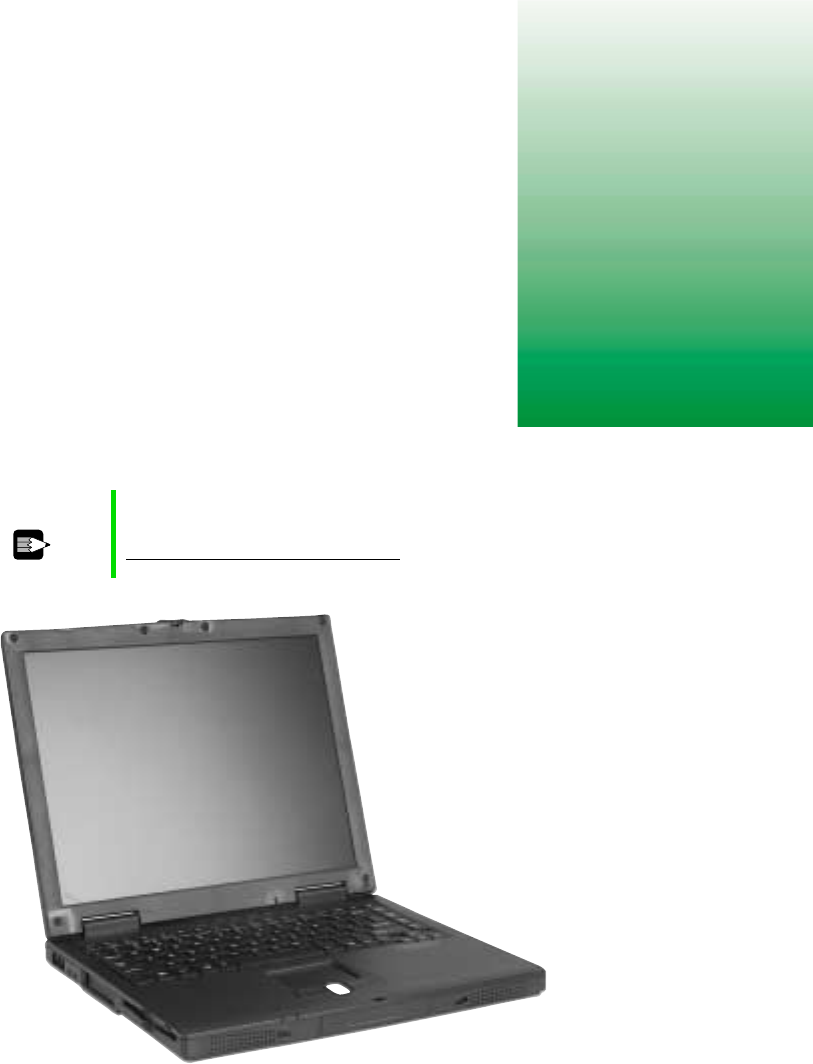
1
1
www.gateway.com
Checking Out
Your Gateway
Solo 1450
Tips & Tricks To access the contents of this guide while you are traveling,
download an electronic copy from
www.gateway.com/support/manlib/.
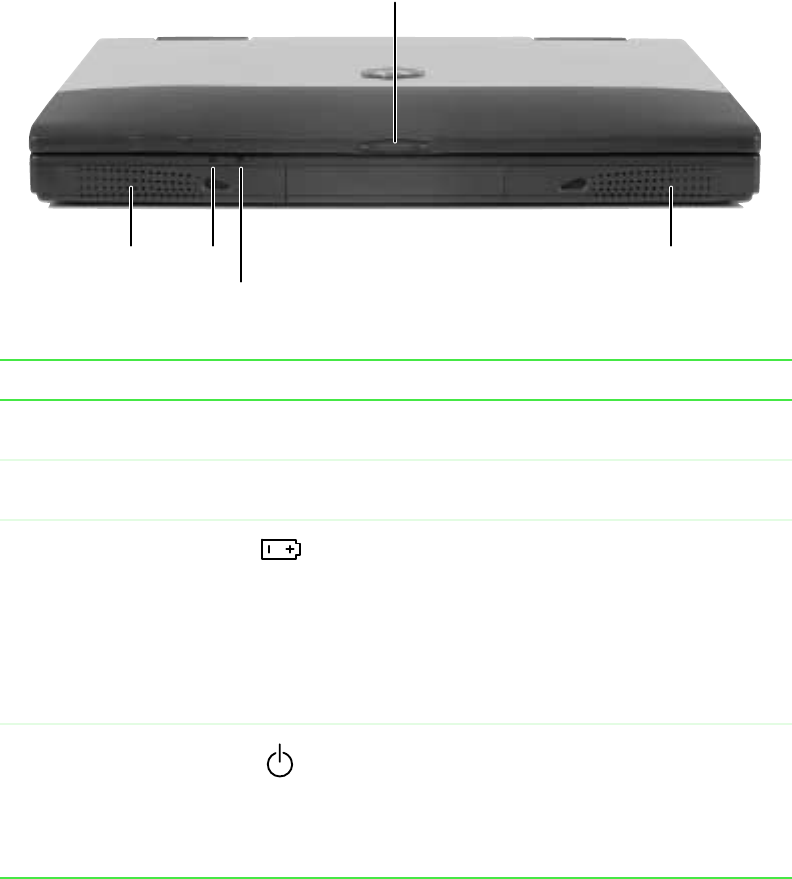
2
Chapter 1: Checking Out Your Gateway Solo 1450
www.gateway.com
Front
Component Icon Description
LCD panel release latch Open the LCD panel by sliding the release latch to the
right.
Speakers Provide audio output. Speakers are disabled while
headphones are connected.
Battery charge indicator The LED shows the battery activity and status.
■LED green – battery is fully charged.
■LED orange – battery is charging.
■LED red – battery is low.
■LED blinking and red – battery is very low.
NOTE: This LED only lights up when the notebook is
plugged in.
Power indicator Lights up when the notebook is turned on and shows the
notebook power status.
■LED on – power is on.
■LED flashing – notebook is in Standby mode.
■LED off – power is off or notebook is in Hibernate
mode.
LCD panel
release
latch
Power
indicator
Battery
charge
indicator
Speaker Speaker
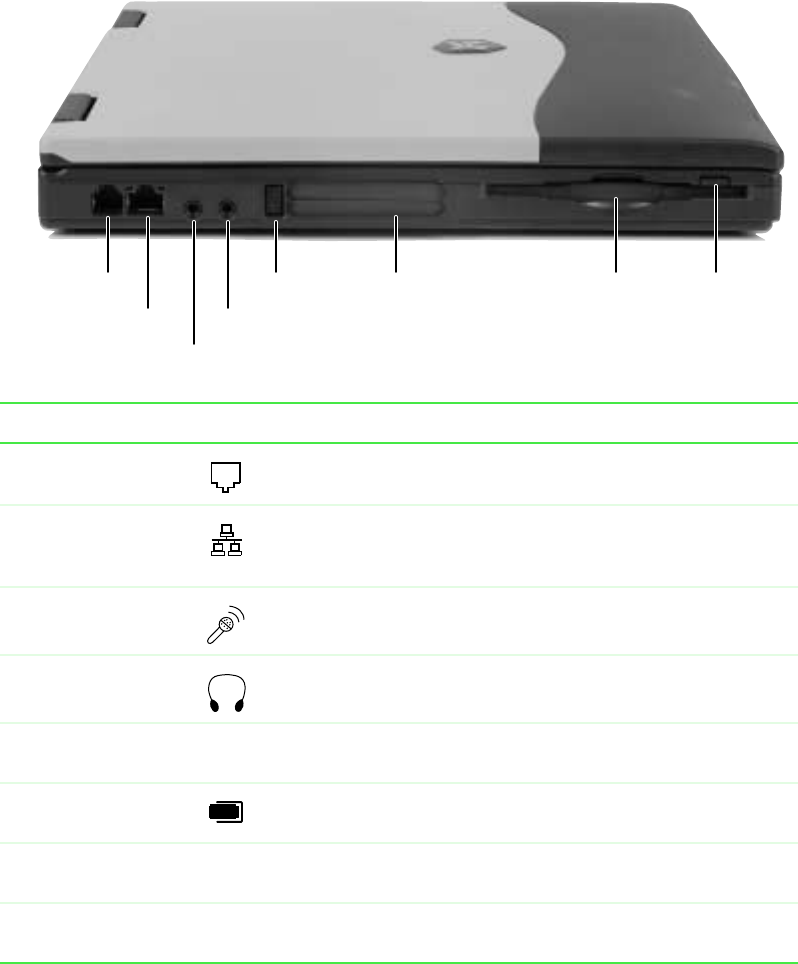
3
Left side
www.gateway.com
Left side
Component Icon Description
Modem jack Plug a modem cable into this jack. For more information, see
“Connecting the modem” on page 26.
Ethernet jack Plug a 10/100 Ethernet network cable into this jack. For more
information, see “Connecting to an Ethernet network” on page 27
and “Networking Your Notebook” on page 139.
Microphone jack Plug a microphone into this jack.
Headphone jack Plug amplified speakers or headphones into this jack.
PC Card eject button Press this eject button to remove the PC Card from the PC Card
slot. For more information, see “Adding PC Cards” on page 130.
PC Card slot Insert one Type II or Type III PC Card into this slot. For more
information, see “Adding PC Cards” on page 130.
Diskette drive Insert a standard 3.5-inch diskette into this drive. For more
information, see “Using diskettes” on page 68.
Diskette drive eject
button Press the eject button to remove a diskette from the drive. For
more information, see “Using diskettes” on page 68.
Microphone jack Headphone jack
Modem jack PC Card
slot
PC Card
eject button
Ethernet jack
Diskette drive
eject button
Diskette
drive
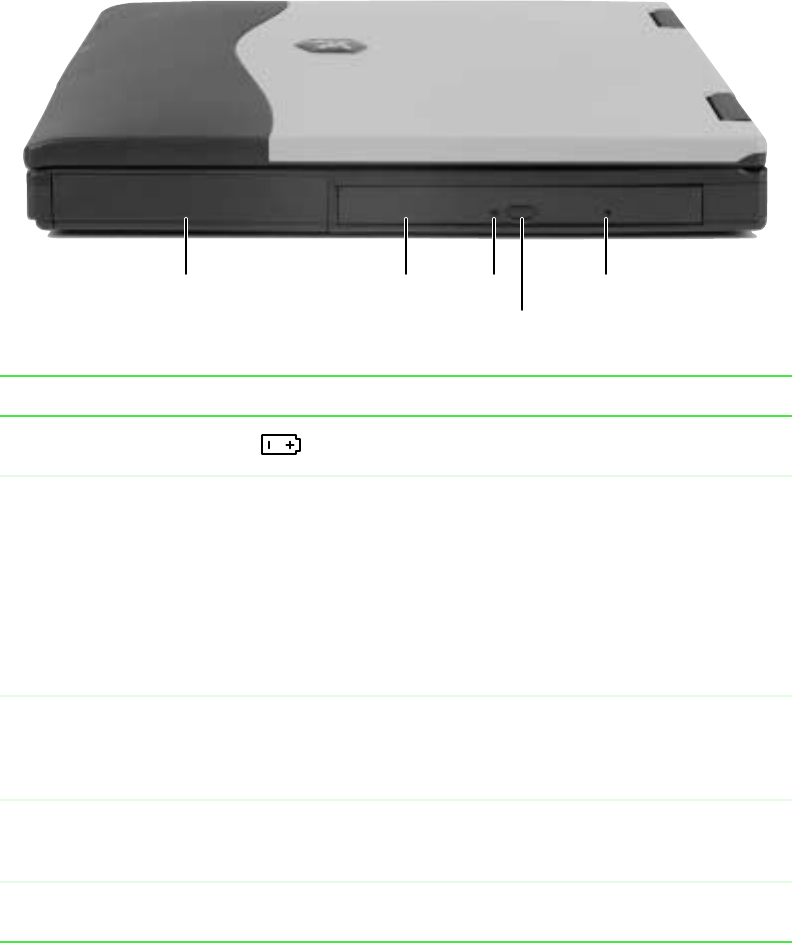
4
Chapter 1: Checking Out Your Gateway Solo 1450
www.gateway.com
Right side
Component Icon Description
Battery bay Insert the battery into this bay. For more information, see
“Changing batteries” on page 103.
CD, CD-RW, DVD, or
combination DVD/CD-RW
drive
Insert CDs, CD-RWs, or DVDs into this drive. For more
information, see “Using a CD, CD-RW, or DVD drive” on
page 69.
To determine the type of drive in your notebook, examine
the drive tray’s plastic cover. A CD Compact Disc logo
indicates a CD drive, a CD-R/RW logo indicates a
recordable/rewritable CD drive, a DVD logo indicates a
DVD drive, and a DVD/CD-R/RW logo indicates a
combination DVD and recordable/rewritable CD drive.
Drive indicator Lights up when the computer is accessing the CD,
CD-RW, DVD, or combination DVD/CD-RW drive. For
more information, see “Using a CD, CD-RW, or DVD
drive” on page 69.
Drive eject button Press the eject button to open the disc tray. For more
information, see “Using a CD, CD-RW, or DVD drive” on
page 69.
Manual eject hole Insert a straightened paperclip into this hole to open the
drive if the drive eject button fails to open it.
CD, CD-RW, DVD,
or DVD/CD-RW
drive Drive eject button
Drive
indicator
Battery bay Manual eject hole
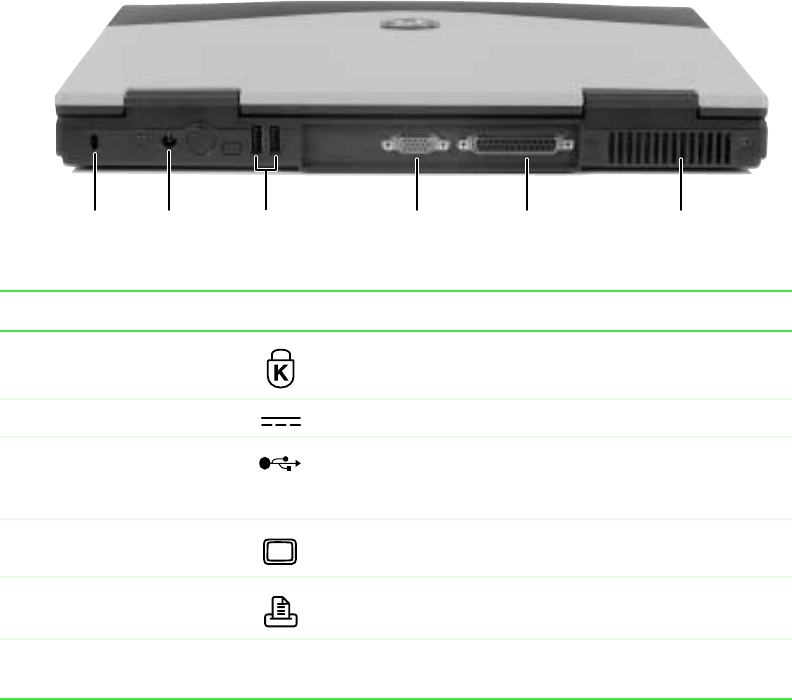
5
Back
www.gateway.com
Back
Component Icon Description
Kensington™ lock slot Secure your computer to an object by connecting a
Kensington cable lock to this slot.
Power connector Plug the AC adapter cable into this connector.
USB ports Plug USB (Universal Serial Bus) devices (such as a USB
Iomega™ Zip™ drive, printer, scanner, or camera) into
these ports.
Monitor port Plug an analog VGA monitor into this port.
Parallel port Plug a parallel device (such as a printer) into this port.
Ventilation fan Helps cool internal components. Do not block or insert
objects into these slots.
Parallel
port
Monitor
port
USB
ports
Power
connector
Kensington
lock slot Ventilation
fan
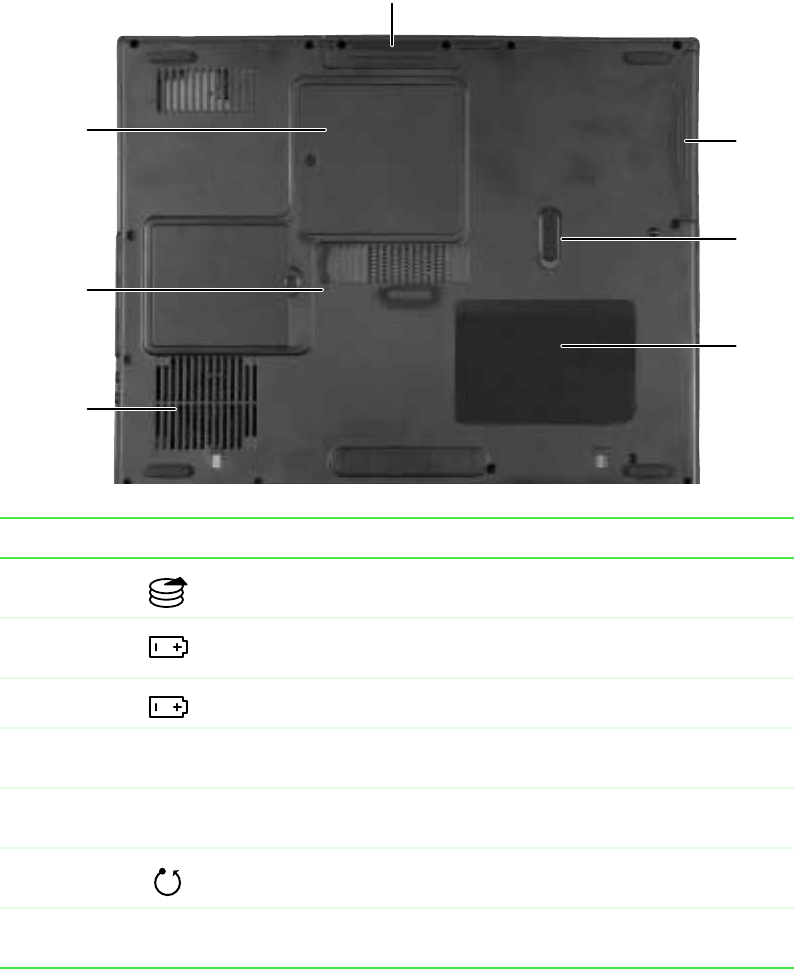
6
Chapter 1: Checking Out Your Gateway Solo 1450
www.gateway.com
Bottom
Component Icon Description
Hard drive Install the hard drive here. For more information, see “Replacing the
hard drive” on page 137.
Battery bay Insert the battery into this bay. For more information, see “Changing
batteries” on page 103.
Battery latch Slide to release the battery.
System label Includes the product model number and serial number. For more
information, see “Identifying your model” on page 9.
Ventilation
fan Helps cool internal components. Do not block or insert objects into these
slots.
Reset hole Insert a straightened paper clip into this hole to manually restart the
system.
Memory bay Install as many as two memory modules into this bay. For more
information, see “Installing memory” on page 133.
Battery
latch
Battery
bay
Hard drive
Memory
bay
System
label
Ventilation
fan
Reset
hole
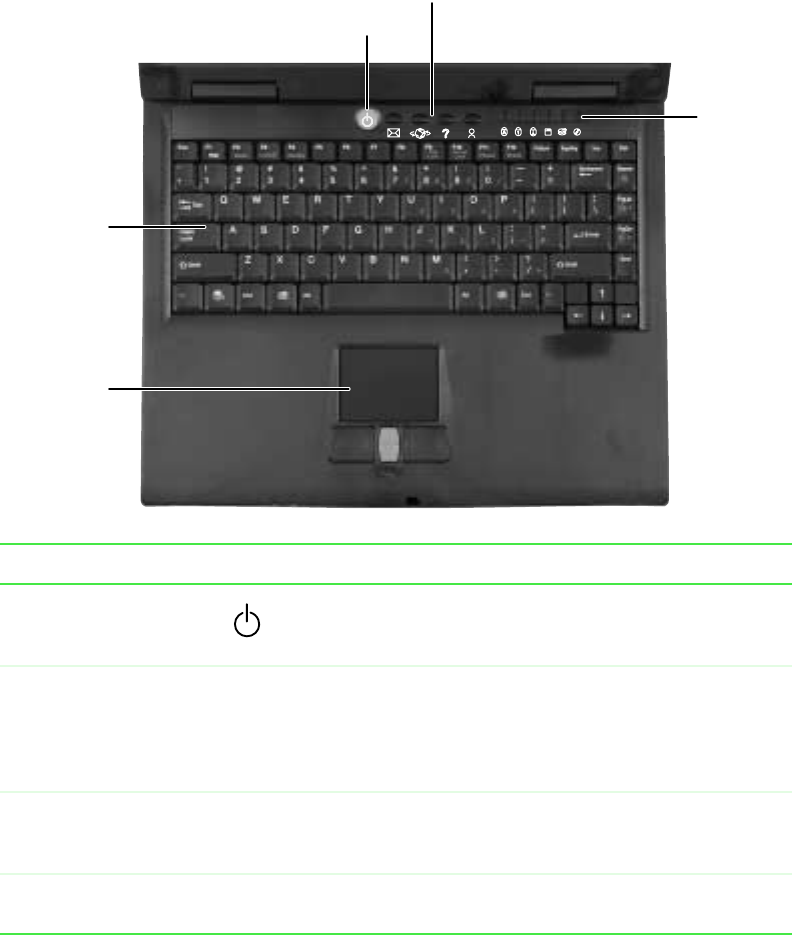
7
Keyboard area
www.gateway.com
Keyboard area
Component Icon Description
Power button Press to turn the power on or off. For more information on
configuring the power button mode, see “Changing power
settings” on page 107.
Multi-function buttons Four multi-function buttons can be assigned to open
applications. By default, these buttons are set to open your
e-mail application, your Web browser, online help, and
another program that you assign. For more information, see
“Multi-function buttons” on page 22.
Status indicators Inform you when a drive is in use or when a button has been
pressed that affects how the keyboard is used. For more
information, see “Status indicators” on page 17.
Touchpad Provides all the functionality of a mouse. For more
information, see “Using the EZ Pad touchpad” on page 23.
Status
indicators
Keyboard
Touchpad
Power button
Multi-function buttons

8
Chapter 1: Checking Out Your Gateway Solo 1450
www.gateway.com
Keyboard A full-sized 86-key keyboard. For more information, see
“Using the keyboard” on page 18.
Component Icon Description

9
Identifying your model
www.gateway.com
Identifying your model
The labels on the bottom of your computer contain information that
identifies your notebook model and its features. Gateway Technical Support
will need this information if you call for assistance.
The following label indicates your computer contains a wireless
communications device.
The Microsoft Certificate of Authenticity label includes the product key code
for your operating system.
Important The label shown below is for informational purposes only.
Label information varies by model.
Insert Solo 1450 Label
Insert Wireless Label
Insert Microsoft XP Label
10
Chapter 1: Checking Out Your Gateway Solo 1450
www.gateway.com
Accessories
Gateway offers accessories that can help you make the most of using your
notebook.
Batteries and automobile/airplane power adapters
If you run your notebook on battery power for extended periods, you may
want to buy an additional battery so that you can swap batteries when
necessary. See “Changing batteries” on page 103 for more information about
using a second battery on your notebook.
With an automobile/airplane power adapter, you can save battery power by
plugging your notebook into an automobile cigarette lighter or an airplane
in-flight power receptacle.
Carrying cases
Gateway has large-capacity carrying cases if you need additional space for
accessories or supplies.
Peripheral devices
You can attach devices such as a keyboard, mouse, printer, or monitor to your
notebook.
Memory
Large programs, such as multimedia games or graphics programs, use a lot of
memory. If your programs are running more slowly than you think they
should, try adding more memory.
Printers
You can attach many types of printers to your notebook. The most common
types are inkjet and laser printers, which print in color or black and white.
See “Installing a printer, scanner, or other peripheral device” on page 28 for
more information about attaching a printer to your notebook.
Inkjet printers and cartridges are relatively inexpensive, but usually they are
slower than laser printers. Using an inkjet color printer, you can print pictures,
banners, and greeting cards, as well as documents.
Laser printers and cartridges are more expensive, but usually they print much
faster than inkjet printers. Laser printers are better than inkjet printers when
you are printing large documents.

11
2
www.gateway.com
Getting Started
This chapter provides basic information about your Gateway notebook. Read
this chapter to find out:
■How to connect the AC adapter
■How to start and turn off your notebook
■How to use the keyboard
■How to use the EZ Pad touchpad
■How to connect the modem
■How to connect to an Ethernet network
■How to install peripheral devices
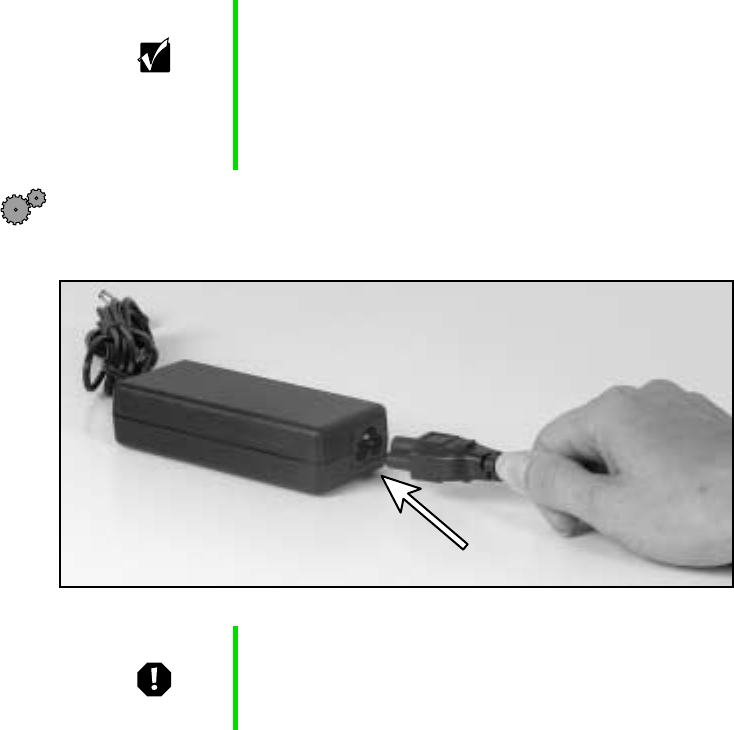
12
Chapter 2: Getting Started
www.gateway.com
Connecting the AC adapter
You can run your notebook using an AC adapter or the notebook battery. The
battery was shipped to you partially charged. You should use the AC adapter
right away to fully charge the battery. Allow 24 hours for the battery to fully
charge.
To connect the AC adapter:
1Connect the power cord to the AC adapter.
Important If the battery is not fully charged before you use your
notebook on battery power for the first time, the battery life
may be much shorter than you expect. If the battery life
seems short even after being charged for 24 hours, the
battery may need to be recalibrated. For information on
recalibrating the battery, see “Recalibrating the battery” on
page 102.
Warning Replace the power cord if it becomes damaged. The
replacement cord must be of the same type and voltage
rating as the original cord or the notebook may be
damaged.
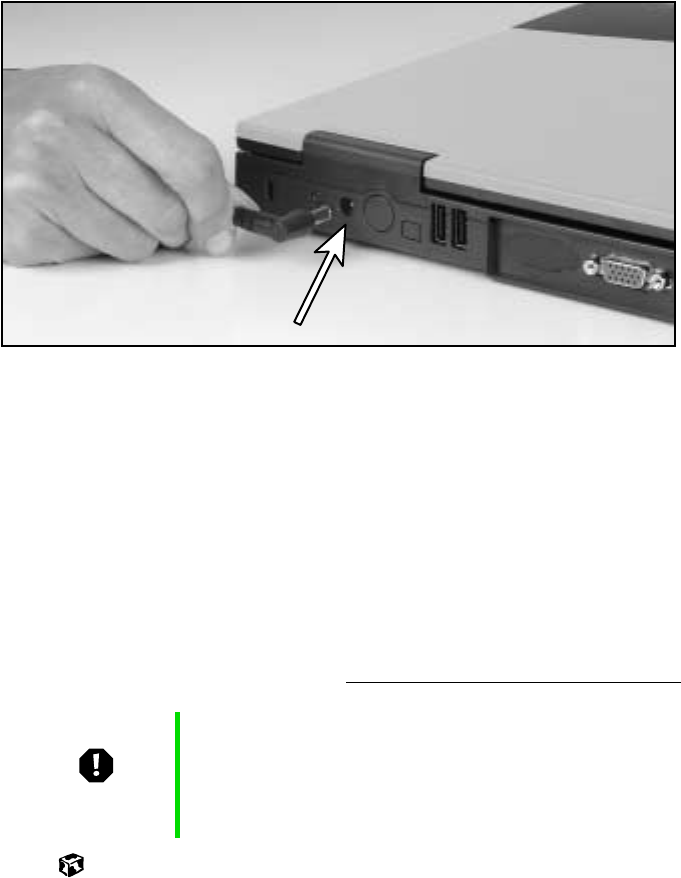
13
Connecting the AC adapter
www.gateway.com
2Connect the AC adapter to your notebook’s power connector.
3Plug the power cord into a wall outlet.
The battery charging indicator turns on (see “Front” on page 2 for the
location of the indicator). If the battery charging indicator does not turn
on, disconnect the adapter from your notebook and repeat Step 2.
4When you finish using your notebook for the first time, turn the
notebook off and leave the notebook connected to AC power for at least
24 hours. The battery charge meters may not show a charge for several
hours. For more information about battery meters on your model, see
“Monitoring the battery charge” on page 100.
5If the battery meters do not show a full charge after 24 hours, contact
Gateway Technical Support at www.gateway.com/support/contact.
Warning Do not attempt to disassemble the AC adapter. The
AC adapter has no user-replaceable or user-serviceable
parts inside. The AC adapter has dangerous voltages that
can cause serious injury or death. Contact Gateway about
returning defective AC adapters.

14
Chapter 2: Getting Started
www.gateway.com
Protecting from power source problems
During a power surge, the voltage level of electricity coming into your
computer can increase to far above normal levels and cause data loss or system
damage. Protect your computer and peripheral devices by connecting them
to a surge protector, which absorbs voltage surges and prevents them from
reaching your computer.
Warning High voltages can enter your computer through both the
power cord and the modem connection. Protect your
computer by using a surge protector. If you have a
telephone modem, use a surge protector that has a
modem jack. If you have a cable modem, use a surge
protector that has an antenna/cable TV jack. During an
electrical storm, unplug both the surge protector and the
modem.
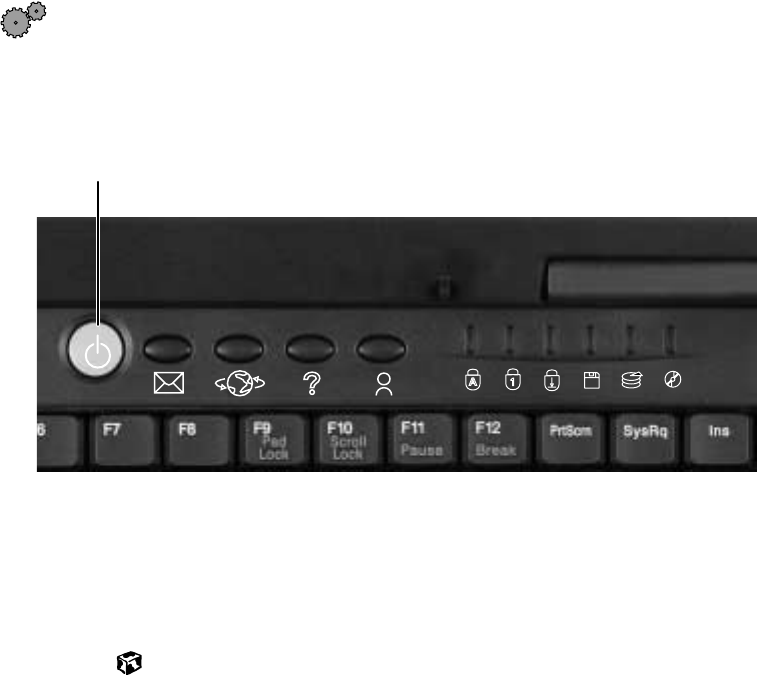
15
Starting your notebook
www.gateway.com
Starting your notebook
To start the notebook:
1Open your notebook by sliding the latch on the front of your notebook
to the right and lifting the LCD panel.
2Press the power button located above the keyboard.
The power button is preset to On/Off mode. However, you can also set
it to function in Standby/Resume mode. For instructions on changing
the power button mode, see “Changing power settings” on page 107.
3If you are starting your notebook for the first time, follow the on-screen
instructions to set up your notebook.
Waking up your notebook
When you have not used your notebook for several minutes, it may enter a
power-saving mode called Standby. While in Standby, the power indicator
flashes.
If your notebook is in Standby mode, “wake” it up by pressing the power
button. For more information on changing power-saving settings, see
“Changing power settings” on page 107.
Power button
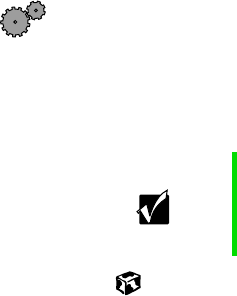
16
Chapter 2: Getting Started
www.gateway.com
Turning off your notebook
To turn off your notebook:
1Click Start, then click Turn Off Computer. The Turn Off Computer dialog box
opens.
2Click Turn Off. Windows shuts down and turns off your notebook.
Important If for some reason you cannot use the Turn Off Computer
option in Windows to turn off your notebook, press and
hold the power button for about five seconds, then release
it.
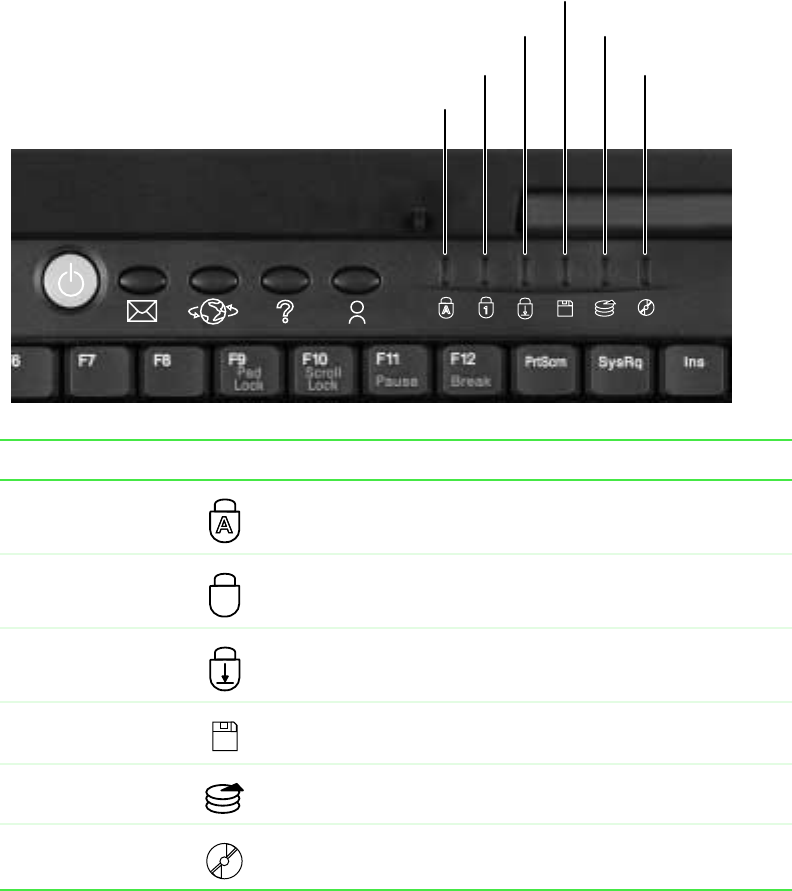
17
Status indicators
www.gateway.com
Status indicators
Status indicators inform you when a drive is being used or when a button
has been pressed that affects how the keyboard is used.
Indicator Icon Description
Caps Lock Caps Lock is turned on.
Pad Lock Pad Lock is turned on.
Scroll Lock Scroll Lock is turned on.
Diskette drive The standard 1.44 MB diskette drive is in use.
Hard drive The hard drive is in use.
Disc drive The CD, CD-RW, DVD, or combination DVD/CD-RW drive is in
use.
Hard drive
Disc drive
Diskette drive
Caps lock
Pad lock
Scroll lock
1
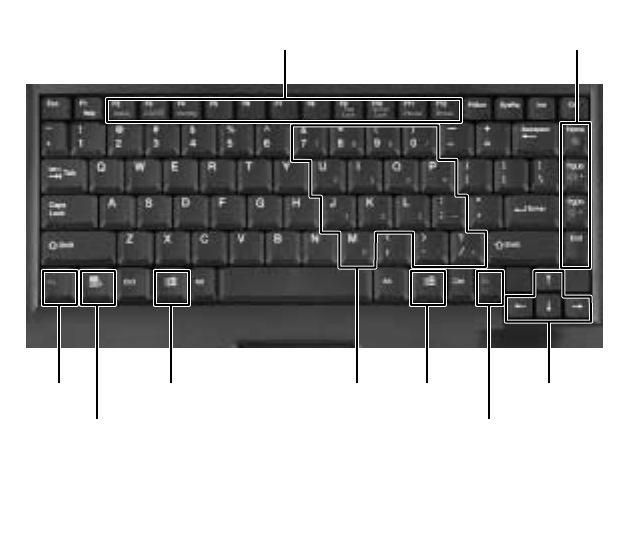
18
Chapter 2: Getting Started
www.gateway.com
Using the keyboard
Your notebook features a full-size keyboard that functions the same as a
desktop computer keyboard. Many of the keys have been assigned alternate
functions, including shortcut keys for Windows, function keys for specific
system operations, and the Pad Lock keys for the numeric keypad.
You can attach an external keyboard to the notebook using a USB or PS/2 port.
You do not need to shut down the notebook to connect a keyboard.
Function/System keys Navigation/Volume keys
Numeric
keypad Arrow keysWindows
key
Fn key
Application
key Fn key
Windows
key
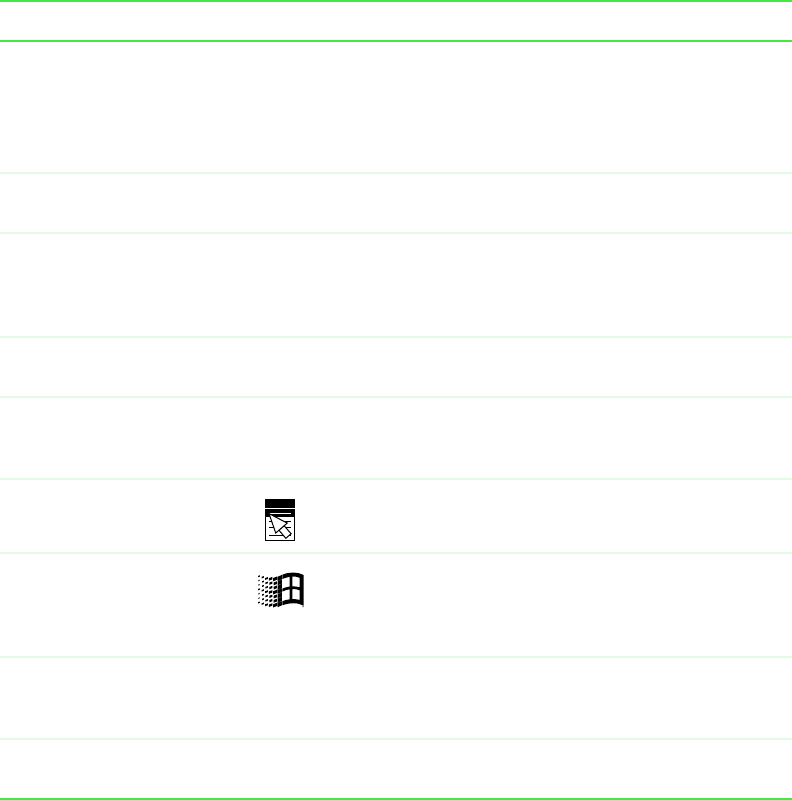
19
Using the keyboard
www.gateway.com
Key types
Many different key types are located on the keyboard. Some keys perform
specific actions when pressed by itself and another action when pressed in
combination with another key.
Key type Icon Description
Function keys Press these keys labeled F1 to F12 to perform actions
in programs. For example, pressing F1 may open help.
Each program uses different function keys for different
purposes. Refer to the program documentation to find
out more about the function key actions.
System keys Press these colored keys in combination with the FNkey
to perform specific actions.
Navigation keys Press these keys to move the cursor to the beginning of
a line, to the end of a line, up the page, down the page,
to the beginning of a document, or to the end of a
document.
Volume keys Press these colored keys in combination with the FNkey
to increase or decrease the volume, or mute the sound.
FN key Press the FNkey in combination with a colored system
key (such as STATUS, STANDBY, or PAUSE) to perform
a specific action.
Application key Press for quick access to shortcut menus and help
assistants in Windows.
Windows key Press to open the Windows Start menu. This key can
also be used in combination with other keys to open
utilities like F(Search utility), R(Run utility), and
E(Explorer utility).
Numeric keypad Use these keys to type numbers when the numeric
keypad is turned on. Press FN+PAD LOCK to turn on the
numeric keypad.
Arrow keys Press these keys to move the cursor up, down, right, or
left.
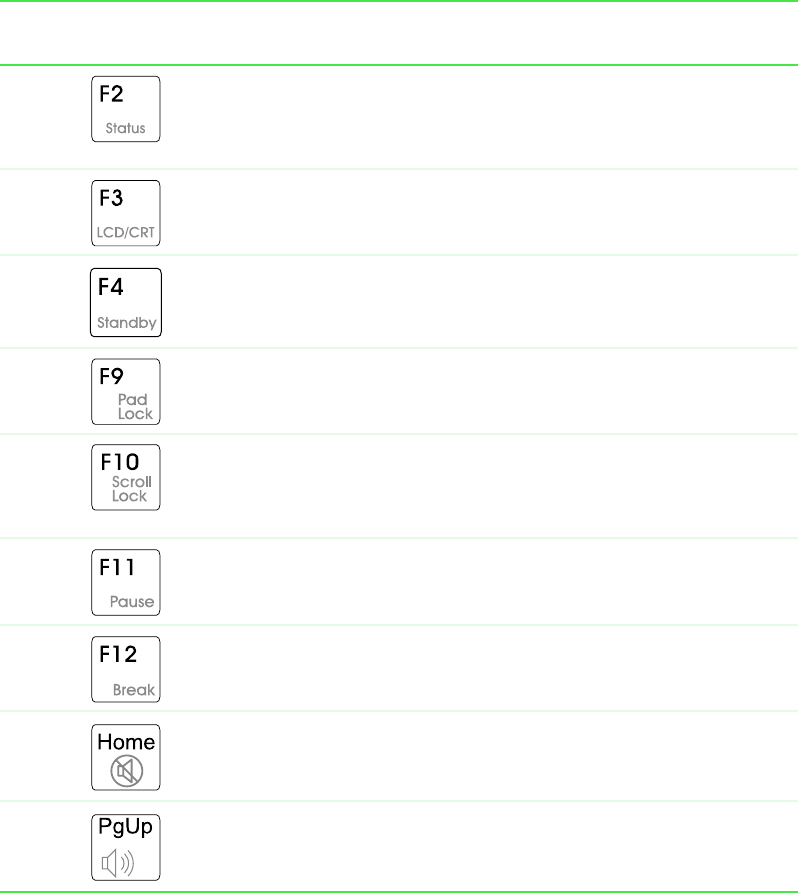
20
Chapter 2: Getting Started
www.gateway.com
System key combinations
When you press an FN key and a system key at the same time, the notebook
performs the action identified by the colored text or icon on the key.
Press and hold FN while
pressing this system key... Too...
Display the power status box in the upper left corner of your screen.
The box shows the battery charge level, the BIOS version, and
whether the AC adapter is being used. Press the key combination
again to close this box.
Toggle the notebook screen between the LCD, an external monitor,
or both displays at the same time. A monitor must be plugged into
the monitor port on the notebook.
Enter Standby mode. Press the power button to leave Standby
mode.
Turn on Pad Lock so you can use the numeric keypad. Press this
key combination again to turn off Pad Lock. The Pad Lock status
indicator appears while this function is turned on.
Pause the text scrolling in a DOS screen. The Scroll Lock status
indicator appears when this function is turned on. Press the key
combination again to continue scrolling. (This function is only
available in some programs.)
Pause execution of a DOS program. (This function is only available
in some programs.)
Stop the currently running DOS program. (This function is only
available in some programs.)
Mute the sound. Press the key combination again to restore the
sound.
Increase volume.

21
Using the keyboard
www.gateway.com
Decrease volume.
Press and hold FN while
pressing this system key... Too...
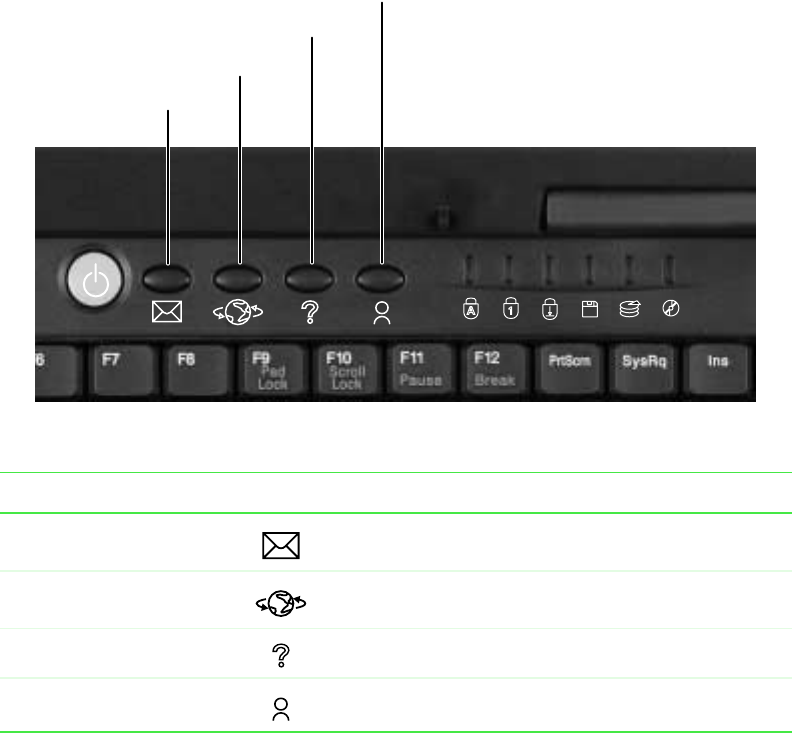
22
Chapter 2: Getting Started
www.gateway.com
Multi-function buttons
The multi-function buttons can be assigned different functions than those
listed. For more information, see “Programming the multi-function buttons”
on page 126.
Button Icon Press to...
E-mail Open your e-mail program.
Internet Open your Web browser.
Help Open online help.
User-defined shortcut Open the program you assign to this key.
E-mail
Internet
Help
User-defined
shortcut
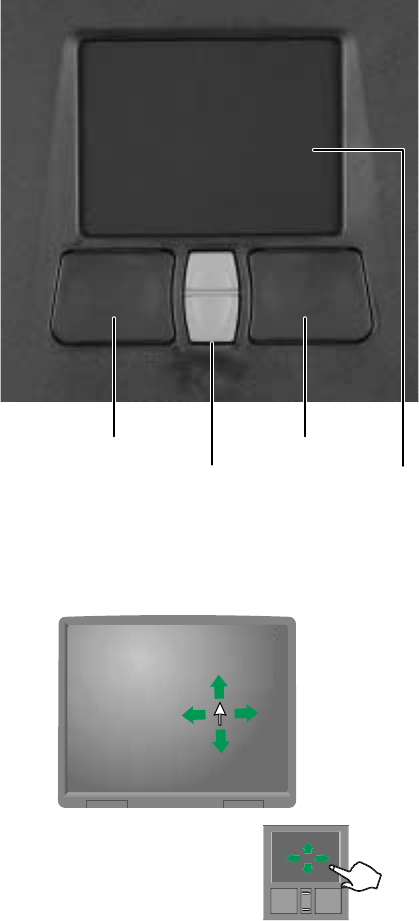
23
Using the EZ Pad touchpad
www.gateway.com
Using the EZ Pad touchpad
The EZ Pad™ consists of a touchpad, two buttons, and a rocker switch.
When you move your finger on the touchpad, the pointer (arrow) on the screen
moves in the same direction.
Touchpad
Left
touchpad
button
Right
touchpad
button
Rocker
switch
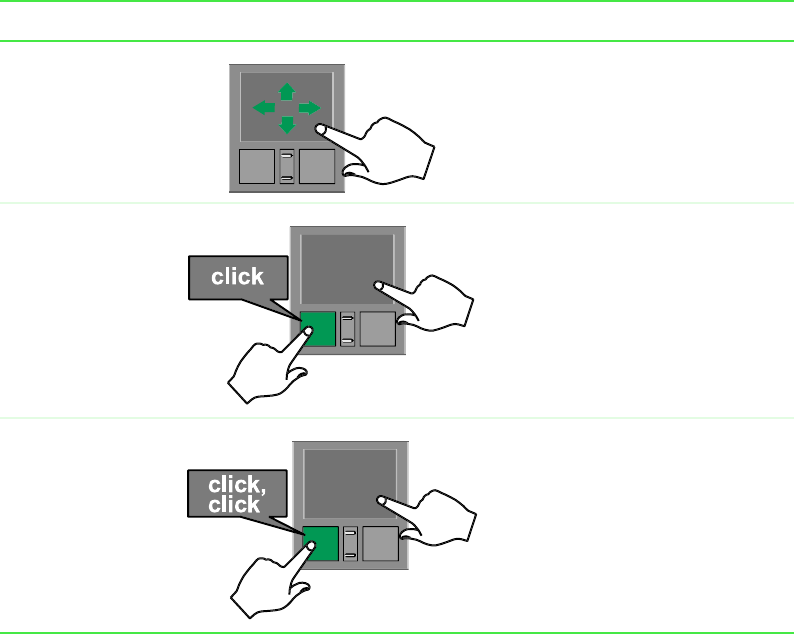
24
Chapter 2: Getting Started
www.gateway.com
You can use the EZ-Pad left and right buttons below the touchpad to select
objects.
You can assign a function to the rocker switch between the touchpad buttons.
This function can be to scroll up or down, maximize or minimize the active
window, or open and close the Start menu. For more information about
programming the rocker switch, see “Changing the touchpad settings” on
page 125.
Using the touchpad
To... Do this...
Move the pointer
on the screen. Move your finger around on the
touchpad. If you run out of space
and need to move the pointer
farther, lift your finger, move it to
the middle of the touchpad, then
continue moving your finger.
Select an object
on the screen. Position the pointer over the
object. Press the left button below
the touchpad once. This action is
called clicking.
Start a program
or open a file or
folder.
Position the pointer over the
object. Press the left button below
the touchpad twice in rapid
succession. This action is called
double-clicking.
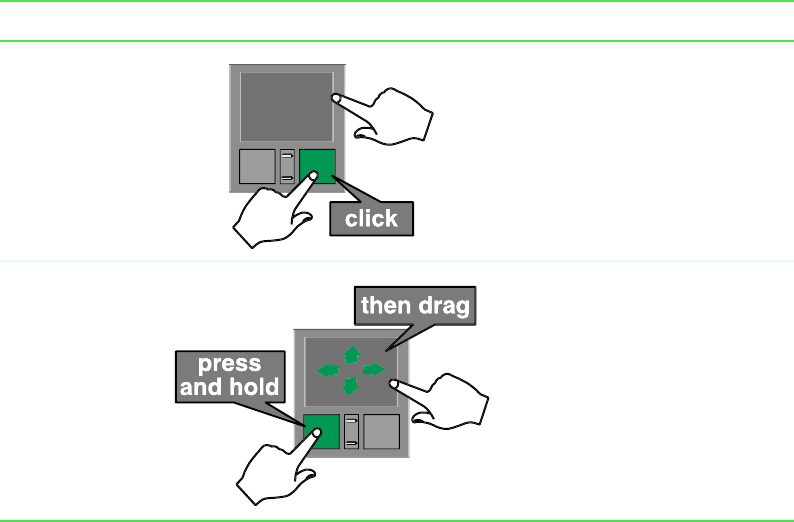
25
Using the EZ Pad touchpad
www.gateway.com
Access a
shortcut menu or
find more
information
about an object
on the screen.
Position the pointer over the
object. Quickly press and release
the right button once. This action
is called right-clicking.
Move an object
on the screen. Position the pointer over the
object. Press the left button and
hold it down, then use the
touchpad to move (drag) the
object to the appropriate part of
the screen. Release the button to
drop the object where you want it.
To... Do this...
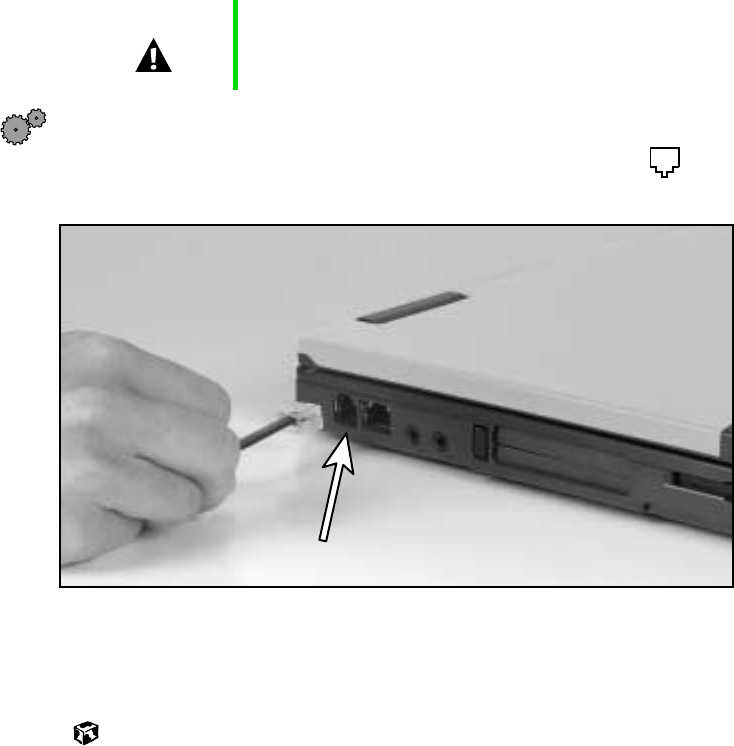
26
Chapter 2: Getting Started
www.gateway.com
Connecting the modem
Your notebook has a built-in 56K modem.
To connect the modem:
1Insert one end of the modem cable into the modem jack on the left
side of the notebook.
2Insert the other end of the modem cable into a telephone wall jack. The
modem will not work with digital or PBX telephone lines.
3Start your notebook, then start your communications software.
Caution To reduce the risk of fire, use only No. 26 AWG or larger
telecommunications line cord.
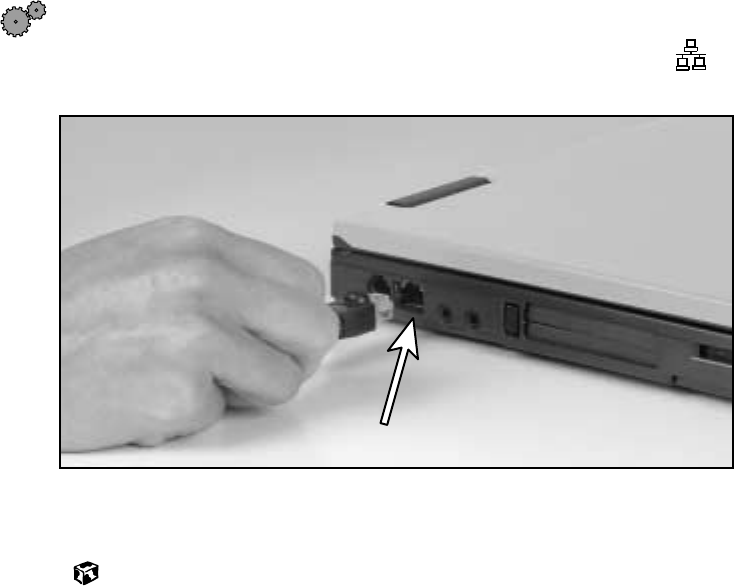
27
Connecting to an Ethernet network
www.gateway.com
Connecting to an Ethernet network
Your notebook has a network jack that you can use to connect it to a 10/100
Ethernet network.
To connect to a network:
1Insert one end of the network cable into the network jack on the
left side of the notebook.
2Insert the other end of the network cable into a network wall jack. Ask
your network administrator to help you select the correct network jack.
Your notebook is now physically connected to the network. Your network
administrator can help you log onto your network.
Broadband Internet connections
You can use your notebook’s Ethernet jack for more than just networking.
Many broadband Internet connections, such as cable modems and DSL
modems, connect to your notebook’s Ethernet jack. For more information,
see “Using the Internet” on page 57 and “Networking Your Notebook” on
page 139.
28
Chapter 2: Getting Started
www.gateway.com
Installing a printer, scanner, or other
peripheral device
Your computer has one or more of the following ports: Universal Serial Bus
(USB) and parallel. These ports are used for connecting peripheral devices such
as printers, scanners, and digital cameras to your computer. For more
information about port locations, see “Checking Out Your Gateway Solo
1450” on page 1.
USB ports support plug-and-play and hot swapping, which means that your
computer will usually recognize such a device whenever you plug it into the
appropriate port. When you use a USB device for the first time, your computer
will prompt you to install any software the device needs. After doing this,
you can disconnect and reconnect the device at any time.
Parallel port devices are not plug-and-play. Refer to the device documentation
for detailed information and installation instructions.

29
3
www.gateway.com
Getting Help
This chapter tells you about additional information resources available to help
you use your computer. It includes the following topics:
■HelpSpot™
■Online help
■Gateway Web site
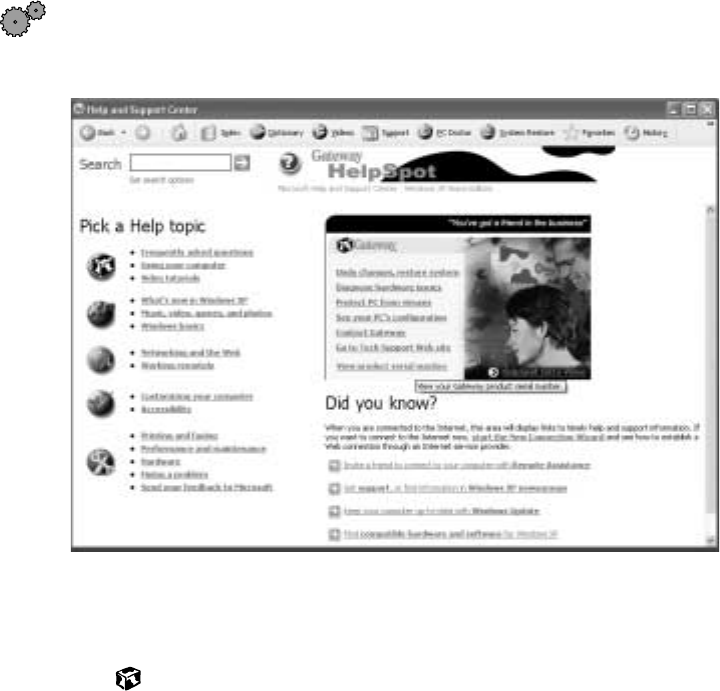
30
Chapter 3: Getting Help
www.gateway.com
HelpSpot
Your computer may include HelpSpot, an easily accessible collection of help
information, troubleshooters, instructional videos, and automated support.
Use HelpSpot to answer questions about Windows and to help you quickly
discover and use the many features of your Gateway computer. HelpSpot also
has an area called Contact Gateway that helps you find the right resource at
Gateway to answer your questions or help solve your problems.
To start HelpSpot:
■Click Start, then click Help and Support. HelpSpot opens.
If this is the first time you have started HelpSpot on your computer, you
may experience a brief wait while HelpSpot builds the help database, then
HelpSpot will display an introductory video.
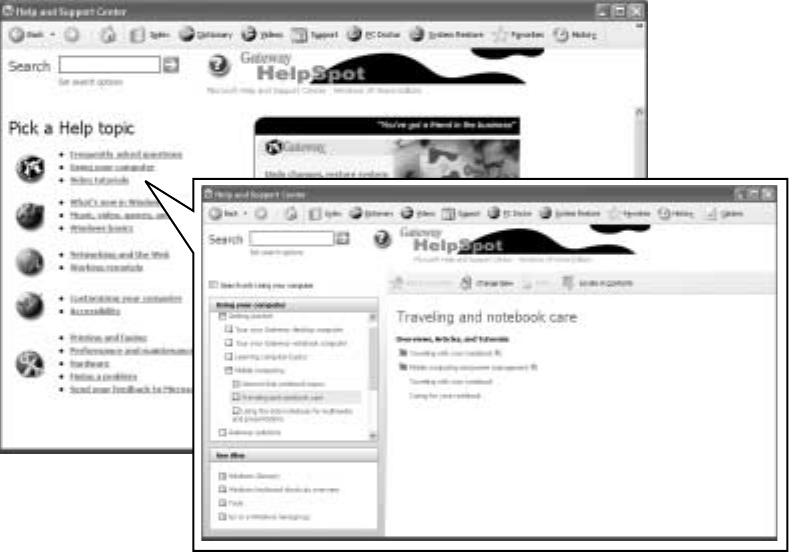
31
HelpSpot
www.gateway.com
You can find help information by clicking a link, performing a search, or
browsing the index. To learn about using your Gateway computer, your
mouse, and other tasks, click the Using your computer link on the HelpSpot
main page.
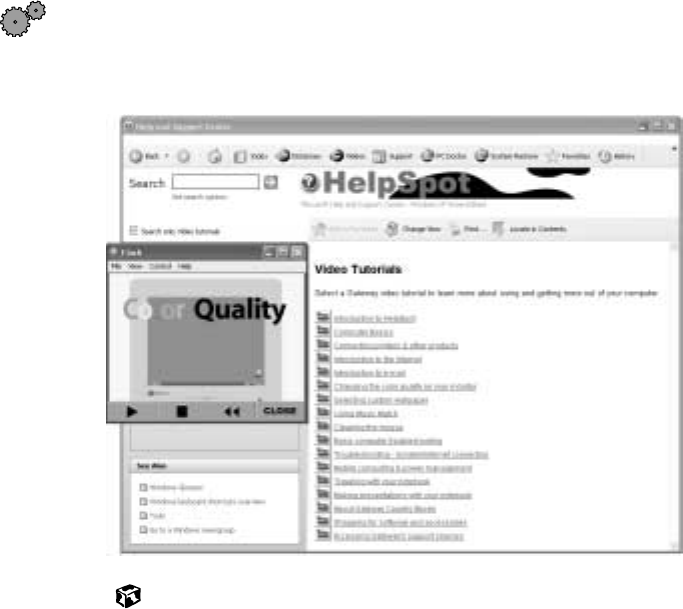
32
Chapter 3: Getting Help
www.gateway.com
HelpSpot Videos
HelpSpot contains several short videos to help introduce you to new concepts
or show you how to perform various tasks.
To play a HelpSpot video:
■To watch a video in HelpSpot, click Video Tutorials on the HelpSpot home
page, then click a video title. The video plays.
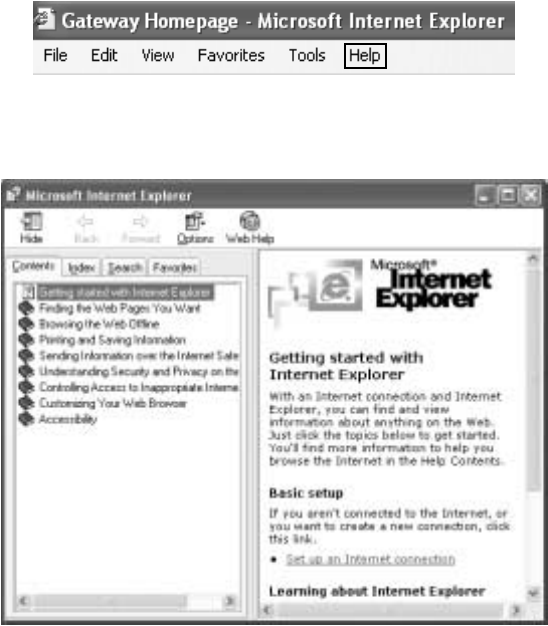
33
Online help
www.gateway.com
Online help
Many programs provide information online so you can research a topic or
learn how to perform a task while you are using the program. Most online
help information can be accessed by selecting a topic from a Help menu or
by clicking a Help button.
You can search for information by viewing the help contents, checking the
index, searching for a topic or keyword, or browsing through the online help.
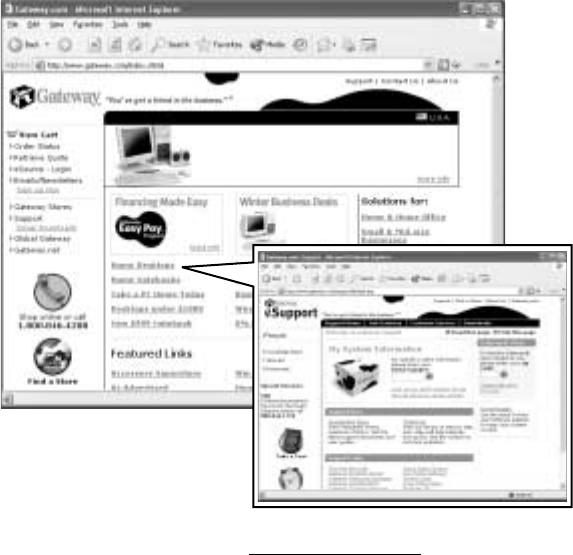
34
Chapter 3: Getting Help
www.gateway.com
Gateway Web site
Gateway provides a variety of information on its Web site to help you use
your computer.
Visit the Gateway Web site at www.gateway.com for:
■Technical documentation and product manuals
■Technical tips and support, including online chat services
■Hardware drivers
■Order status
■Frequently asked questions (FAQs)
For more information about connecting to the Internet, see “Learning about
the Internet” on page 58.

35
4
www.gateway.com
Windows
Basics
Read this chapter to get basic information on how to:
■Use the Windows desktop
■Manage files and folders
■Work with documents
■Use shortcuts
Help and
Support For more information about Windows, click Start, then
click Help and Support.
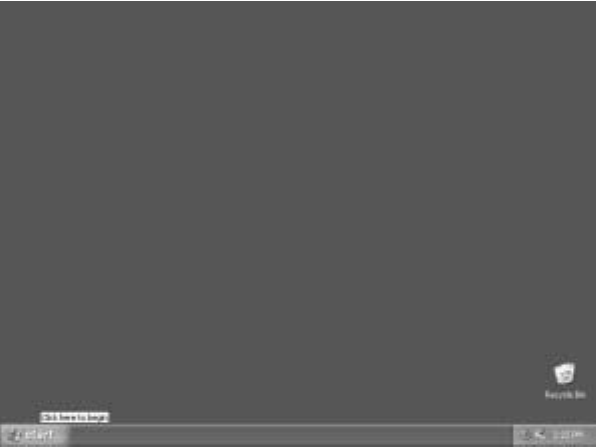
36
Chapter 4: Windows Basics
www.gateway.com
About the Windows environment
After your computer starts, the first screen you see is the Windows desktop.
The desktop is like the top of a real desk. Think of the desktop as your
personalized work space where you open programs and perform other tasks.
Your desktop may be different from the example shown below, depending on
how your computer is set up.
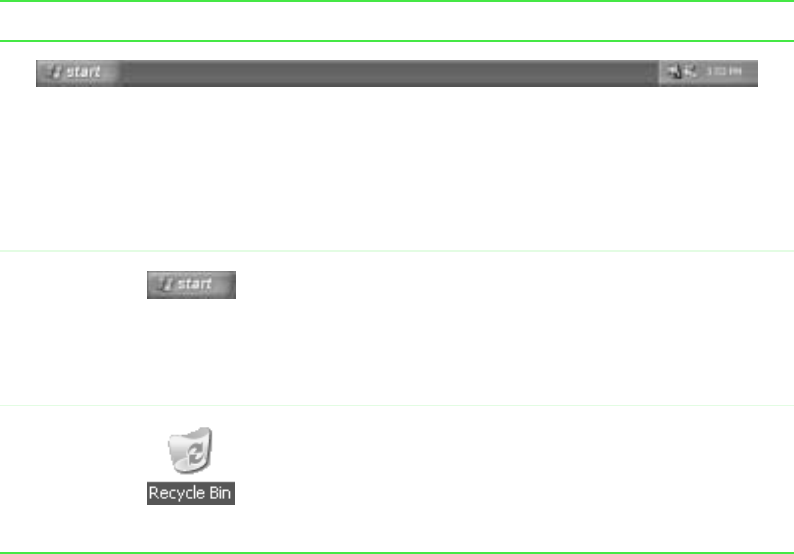
37
Using the desktop
www.gateway.com
Using the desktop
The desktop contains the taskbar, the Start button, and the Recycle Bin icon.
Desktop elements Description
The taskbar is the bar at the bottom of the screen
containing the Start button on the left and a clock
on the right. Other buttons on the taskbar
represent programs that are running.
Click a program’s button on the taskbar to open
the program’s window.
The Start button provides access to programs,
files, help for Windows and other programs, and
computer tools and utilities.
Click the Start button, then open a file or program
by clicking (selecting) an item on the menu that
opens.
The Recycle Bin is where files, folders, and
programs that you discarded are stored. You
must empty the Recycle Bin to permanently
delete them from your computer. For instructions
on how to use the Recycle Bin, see “Deleting files
and folders” on page 45.
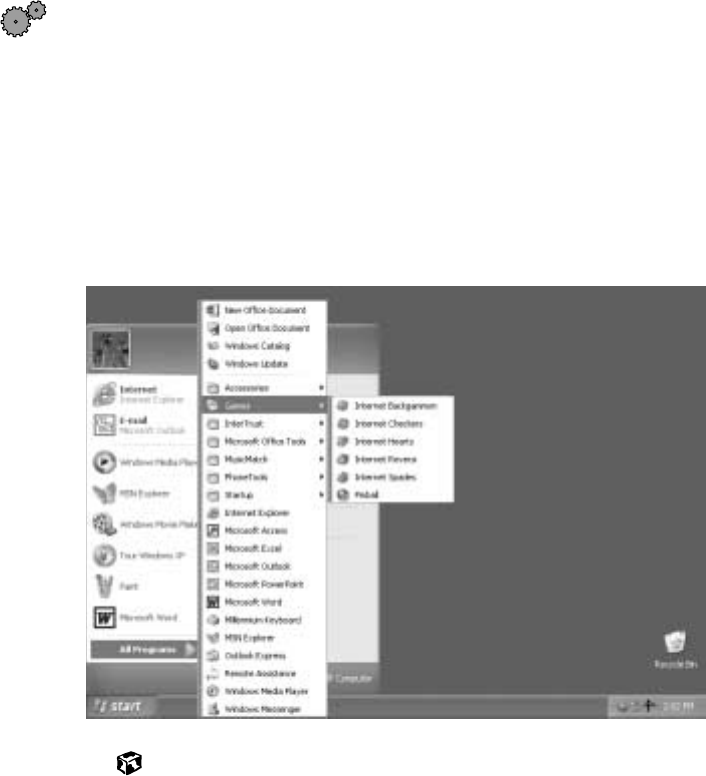
38
Chapter 4: Windows Basics
www.gateway.com
Using the Start menu
You can start programs, open files, customize your system, get help, search
for files and folders, and more using the Start menu.
To use the Start menu:
1Click the Start button on the lower left of the Windows desktop. The Start
menu opens showing you the first level of menu items.
2To see all programs and files in the Start menu, click All Programs.
When you move the mouse pointer over any menu item that has an
arrow next to it, another menu, or submenu, opens and reveals related
files, programs, or commands.
3Click a file or program to open it.
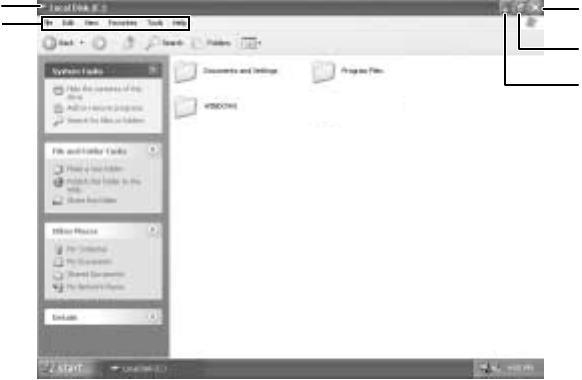
39
Identifying Window items
www.gateway.com
Identifying Window items
When you double-click the icon for a drive, folder, file, or program, a window
opens on the desktop. This example shows the Local Disk (C:) window, which
opens after double-clicking the Local Disk (C:) icon in the My Computer
window.
Minimize
Maximize
Close
Title bar
Menu bar
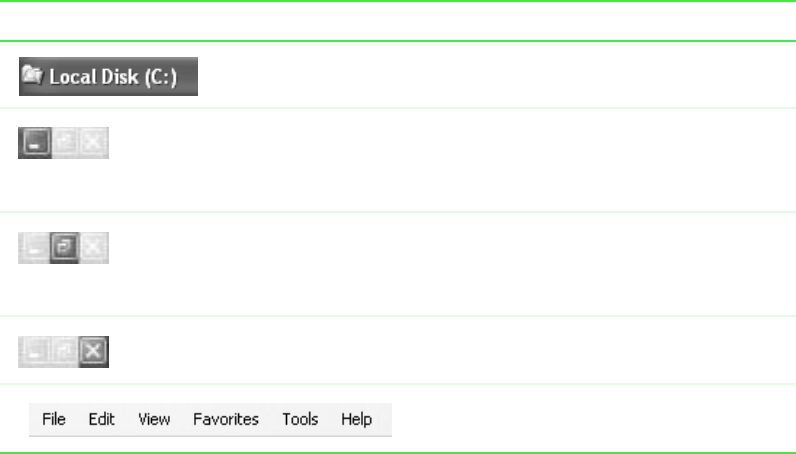
40
Chapter 4: Windows Basics
www.gateway.com
Every program window looks a little different because each has its own menus,
icons, and controls. Most windows include these items:
Window item Description
The title bar is the horizontal bar at the top
of a window that shows the window title.
Clicking the minimize button reduces the
active window to a button on the taskbar.
Clicking the program button in the taskbar
opens the window again.
Clicking the maximize button expands the
active window to fit the entire screen. Clicking
the maximize button again restores the
window to its former size.
Clicking the close button closes the active
window or program.
Clicking an item on the menu bar starts an
action such as Print or Save.
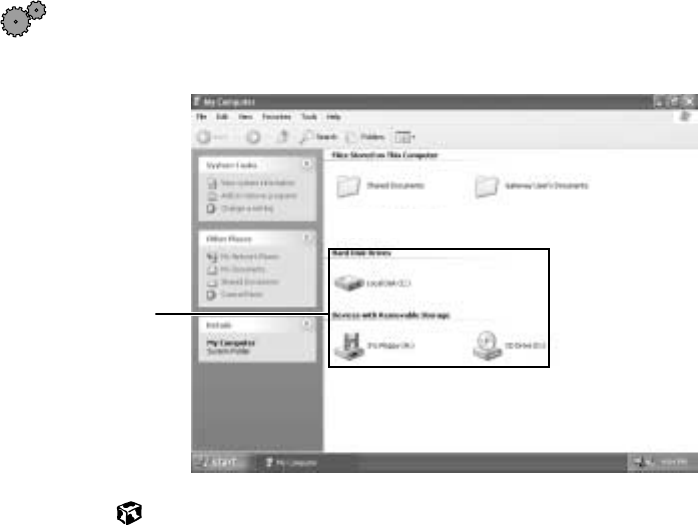
41
Working with files and folders
www.gateway.com
Working with files and folders
You can organize your files and programs to suit your preferences much like
you would store information in a file cabinet. You can store these files in
folders and copy, move, and delete the information just as you would
reorganize and throw away information in a file cabinet.
Viewing drives
Drives are like file cabinets because they hold files and folders. A computer
almost always has more than one drive. Each drive has a letter, usually Local
Disk (C:) for the hard drive and 3½ Floppy (A:) for the diskette drive. You may
also have more drives such as a CD, CD-RW, DVD, or combination
DVD/CD-RW drive.
To view the drives on your computer:
■Click Start, then click My Computer on the Start menu.
Drives
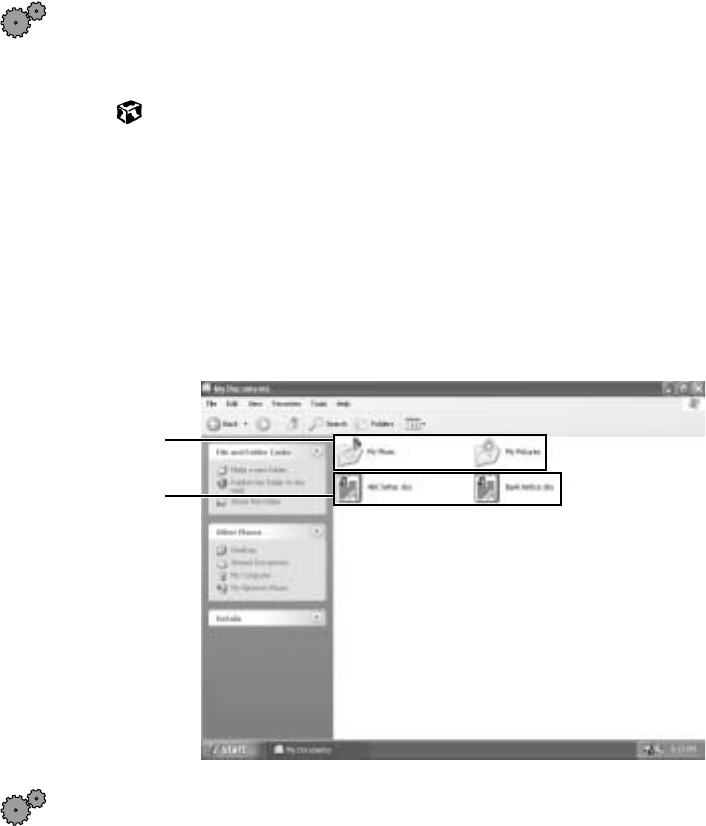
42
Chapter 4: Windows Basics
www.gateway.com
To see the files and folders on a drive:
■Double-click the drive icon. If you do not see the contents of a drive after
you double-click its icon, click Show the contents of this drive.
Creating folders
Folders are much like the folders in a file cabinet. They can contain files and
other folders.
Files are much like paper documents—letters, spreadsheets, and pictures—that
you keep on your computer. In fact, all information on a computer is stored
in files.
To create a folder:
1Click Start, then click My Computer on the Start menu.
2Double-click the drive or folder, for example the Local Disk (C:), where you
want to put the new folder.
The drive or folder window opens. If you do not see the contents of the
drive or folder, click Show the contents of this drive.
Folders
Files

43
Working with files and folders
www.gateway.com
3Click File, New, then click Folder. The new folder is created.
4Type a name for the folder, then press ENTER. The new folder name
appears by the folder icon.
Copying and moving files and folders
The skills you need to copy and move files are called copying, cutting, and
pasting.
When you copy and paste a file or folder, you place a copy of the file or folder
on the Windows clipboard, which temporarily stores it. Then, when you decide
what folder you want the copy to go in (the destination folder), you paste it
there.
When you cut and paste a file or folder, you remove the file or folder from
its original location and place the file or folder on the Windows clipboard.
When you decide where you want the file or folder to go, you paste it there.
To copy a file or folder to another folder:
1Right-click (press the right mouse button) the file or folder that you want
to copy. A pop-up menu opens on the desktop.
2Click Copy on the pop-up menu.
3Open the destination folder.
4With the pointer inside the destination folder, right-click.
5Click Paste. A copy of the file or folder appears in the new location.
Important The clipboard stores whatever you cut or copy until you
cut or copy again. Then the clipboard contains the new
information only. Therefore, you can paste copies of a file
or folder into more than one place, but as soon as you copy
or cut a different file or folder, the original file or folder is
deleted from the clipboard.
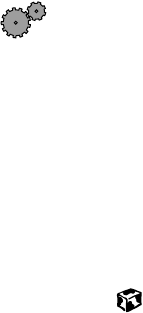
44
Chapter 4: Windows Basics
www.gateway.com
To move a file or folder to another folder:
1Right-click (press the right mouse button) the file or folder that you want
to move. A pop-up menu opens on the desktop.
2Click Cut on the pop-up menu.
3Open the destination folder.
4With the pointer inside the destination folder, right-click.
5Click Paste. The file or folder you moved appears in its new location and
is removed from its old location.

45
Working with files and folders
www.gateway.com
Deleting files and folders
When you throw away paper files and folders, you take them from the file
cabinet and put them in a trash can. Eventually the trash can is emptied.
In Windows, you throw away files and folders by first moving them to
Windows trash can, called the Recycle Bin, where they remain until you decide
to empty the bin.
You can recover any file in the Recycle Bin as long as the bin has not been
emptied.
To delete files or folders:
1In My Computer or Windows Explorer, click the files or folders that you
want to delete. For instructions on how to select multiple files and folders,
see “Shortcuts” on page 55.
2Click File, then click Delete. Windows moves the files and folders to the
Recycle Bin.
To recover files or folders from the Recycle Bin:
1Double-click the Recycle Bin icon. The Recycle Bin window opens and lists
the files and folders you have thrown away since you last emptied it.
2Click the files or folders that you want to restore. For instructions on how
to select multiple files and folders, see “Shortcuts” on page 55.
3Click File, then click Restore. Windows returns the deleted files or folders
to their original locations.
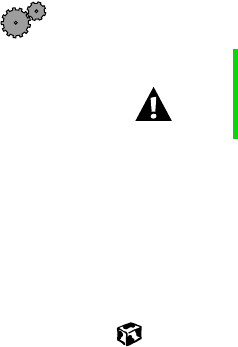
46
Chapter 4: Windows Basics
www.gateway.com
To empty the Recycle Bin:
1Double-click the Recycle Bin icon on the desktop. The Recycle Bin window
opens.
2Click File, then click Empty Recycle Bin. Windows asks you if you are sure
that you want to empty the bin.
3Click Yes. Windows permanently deletes all files in the Recycle Bin.
Caution Emptying the Recycle Bin permanently erases any files or
folders in the bin. These files cannot be restored.
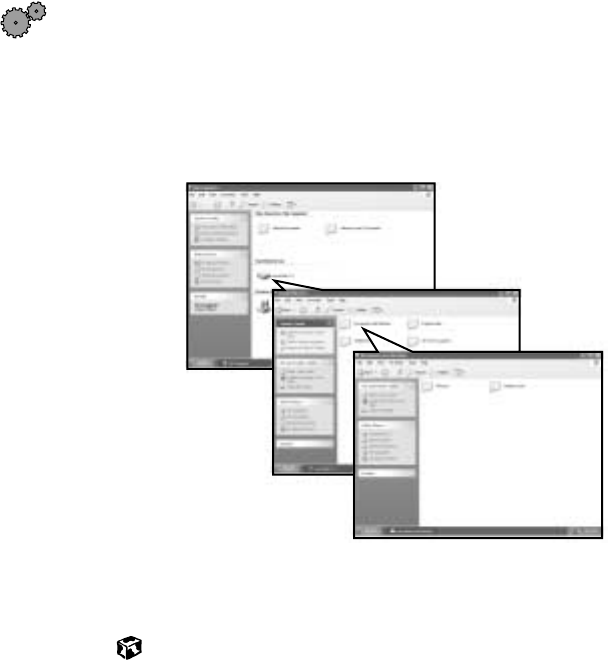
47
Working with files and folders
www.gateway.com
Browsing for files and folders
A file or folder that you need is rarely right on top of your Windows desktop.
It is usually on a drive inside a folder that may be inside yet another folder,
and so on.
Windows drives, folders, and files are organized in the same way as a real file
cabinet in that they may have many levels (usually many more levels than
a file cabinet, in fact). So you usually will have to search through levels of
folders to find the file or folder that you need. This is called browsing.
To browse for a file:
1Click Start, then click My Computer.
2Double-click the drive or folder that you think contains the file or folder
that you want to find. If you do not see the contents of a folder, click
Show the contents of this folder.
3Continue double-clicking folders and their subfolders until you find the
file or folder you want.
48
Chapter 4: Windows Basics
www.gateway.com
Searching for files
If you are looking for a particular file or folder or a set of files or folders that
have characteristics in common, but you do not remember where they are
stored on your hard drive, you can use the Search utility to search by:
■Name or part of a name
■Creation date
■Modification date
■File type
■Text contained in the file
■Time period in which it was created or modified
You can also combine search criteria to refine searches.
Files and folders found using these utilities can be opened, copied, cut,
renamed, or deleted directly from the list in the results window.
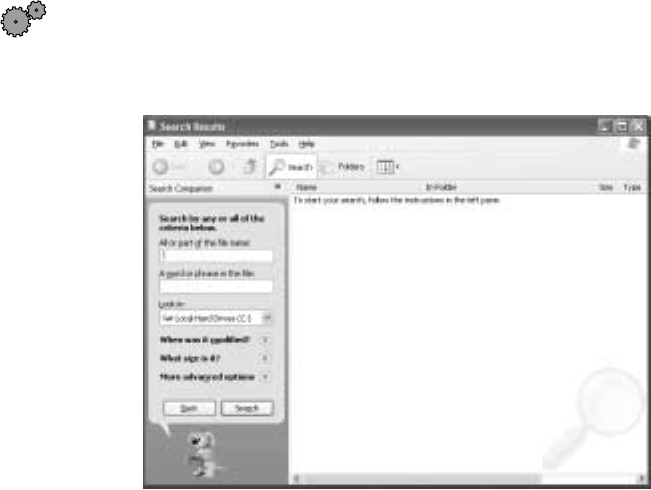
49
Searching for files
www.gateway.com
Using the Search utility
To find files and folders using the Search utility:
1Click Start, then click Search. The Search Results window opens. Click All
files and folders.
2If you want to search by file or folder name, type in all or part of the
file or folder name in the name box in the left pane of the window.
■If you type all of the name, Search will list all files and folders of
that name.
■If you type part of the name, Search will list all of the file and folder
names containing the letters you typed.
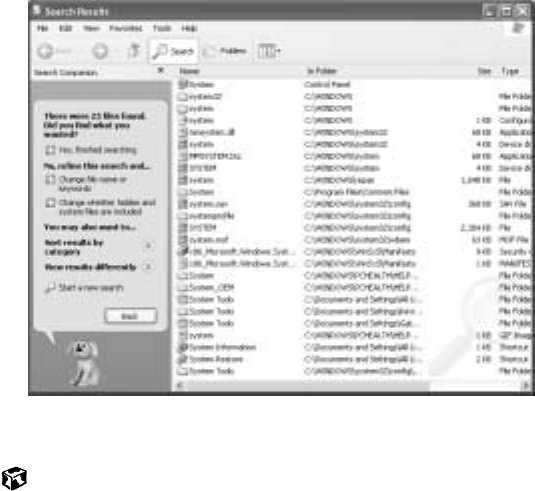
50
Chapter 4: Windows Basics
www.gateway.com
3Click Search. When the search is completed, Windows lists the files and
folders whose names contain the text that you searched for.
4Open a file, folder, or program by double-clicking the name in the list.
Using advanced search options
Search can find files meeting more criteria than file name. You can select
options to narrow your search by selecting the search options that you want.
You can search by the:
■Date the file was created or modified.
■Size of the file.
■Type of file, such as a program or a text document.
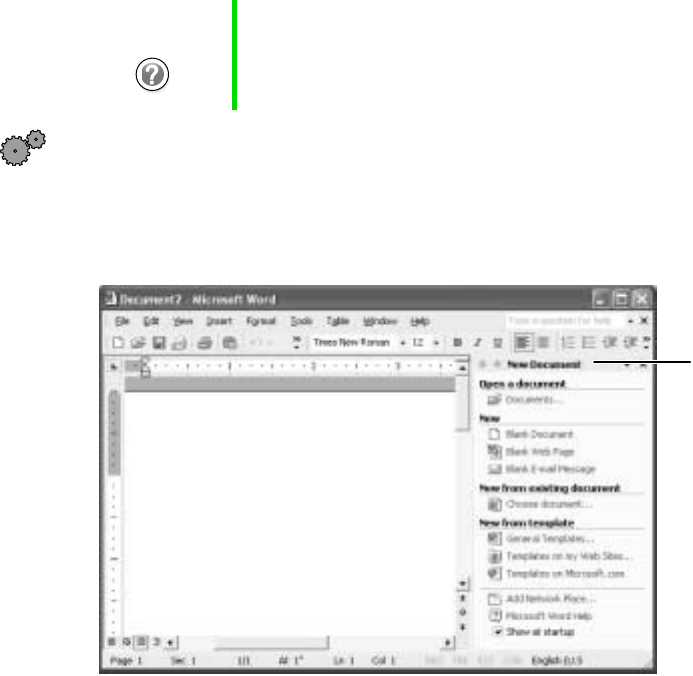
51
Working with documents
www.gateway.com
Working with documents
Computer documents include word processing files, spreadsheet files, or other
similar files. The basic methods of creating, saving, opening, and printing a
document apply to most of these types of files.
The following examples show how to create, save, open, and print a document
using Microsoft® Word. Similar procedures apply to other programs such as
Microsoft Excel, Microsoft WordPad, and Microsoft Publisher.
For more information about using a program, click Help on its menu bar.
Creating a new document
To create a new document:
1Click Start, All Programs, then click Microsoft Word. Microsoft Word starts
and a blank document opens.
2Click File, then click New. The New Document pane opens.
Help and
Support For more information about creating a document in
Windows XP, click Start, then click Help and Support.
New
Document
pane
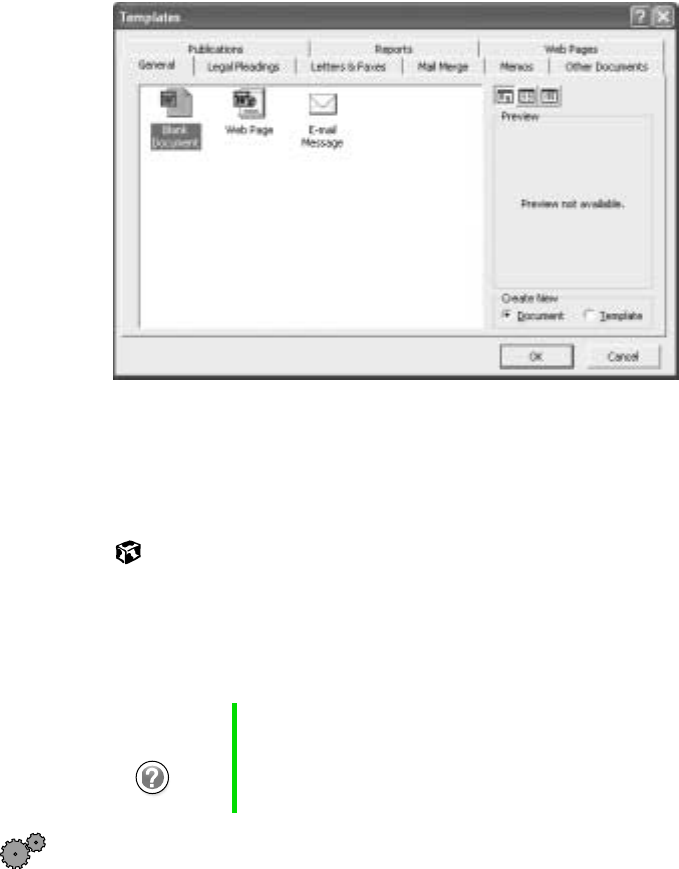
52
Chapter 4: Windows Basics
www.gateway.com
3Click General Templates. The Templates dialog box opens.
4Click a tab for the type of document you want to create, click a document
template style, then click OK. The document template opens.
5Begin composing your document. Use the menus and toolbar buttons at
the top of the window to format the document.
Saving a document
After you create a document, you need to save it if you want to use it later.
To save a document in Microsoft Word:
1Click File, then click Save. The Save As dialog box opens.
2In the Save in list, click the folder where you want to save the file.
Help and
Support For more information about saving a document in
Windows XP, click Start, then click Help and Support.
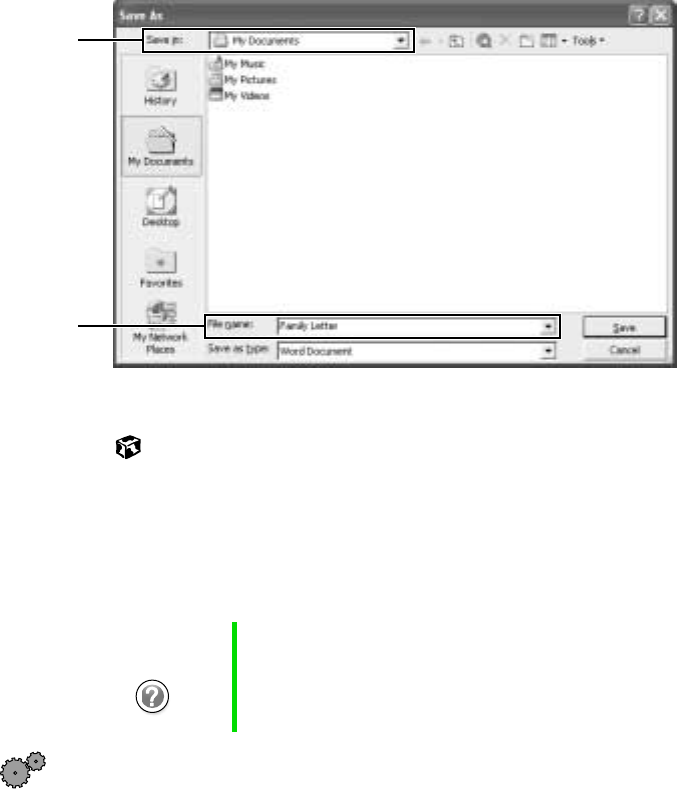
53
Working with documents
www.gateway.com
3Type the new file name.
4Click Save.
Opening a document
To view, revise, or print an existing document, first you need to open it. Open
the document in the program that it was created in.
To open a document in Microsoft Word:
1Click Start, All Programs, then click Microsoft Word. Microsoft Word starts
and a blank document opens.
2Click File, then click Open.
Help and
Support For more information about opening a document in
Windows XP, click Start, then click Help and Support.
File
folder
File
name
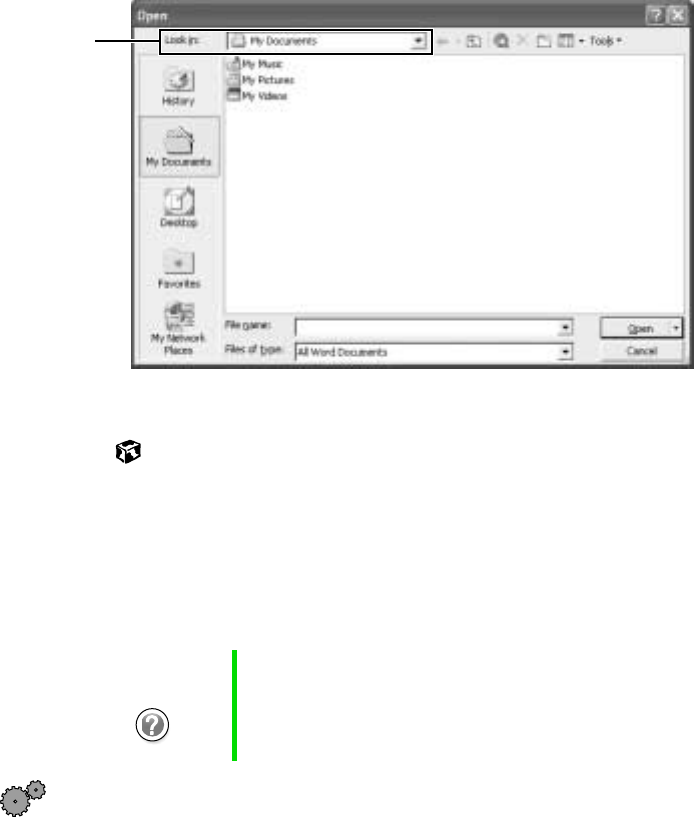
54
Chapter 4: Windows Basics
www.gateway.com
3Find the folder you want to open in the Look in list.
4Double-click the document file name. The document opens.
Printing a document
To print a document, you must have a printer connected to your computer
or have access to a network printer. For more information about installing or
using your printer, refer to the printer documentation.
To print a document in Microsoft Word:
1Make sure that the printer is turned on and loaded with paper.
2Start Microsoft Word and open a document.
Help and
Support For more information about printing a document in
Windows XP, click Start, then click Help and Support.
Look in
list
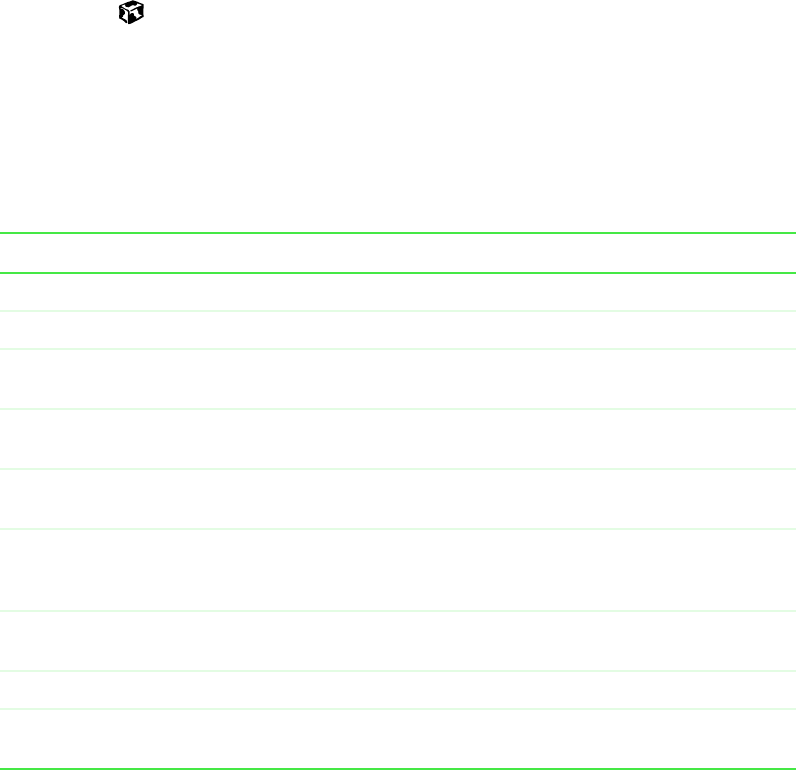
55
Shortcuts
www.gateway.com
3Click File, then click Print. The Print dialog box opens.
4Set the print options, then click OK. The document prints.
Shortcuts
The following table shows a few shortcuts that you can use in Windows and
almost all programs that run in Windows. For more information on Windows
shortcuts, see your Windows or program documentation.
To... Do this...
Copy a file, folder, text, or graphic Click the item, then press CTRL +C.
Cut a file, folder, text, or graphic Click the item, then press CTRL +X.
Paste a file, folder, text, or graphic Click inside the folder or window where you want to paste
the object, then press CTRL +V.
Select multiple items in a list or in a
window Click the first item, press and hold down the CTRL key,
then click each of the remaining items.
Select multiple adjacent items in a list
or window Click the first item in the list, press and hold down the
SHIFT key, then click the last item in the list.
Permanently delete a file or folder Click the file or folder, then press SHIFT +DELETE. The
file is permanently deleted. The file or folder is not stored
in the Recycle Bin.
Rename a file or folder Click the file or folder, press F2, type the new name, then
press ENTER.
Close the active window or program Press ALT +F4.
Switch to a different file, folder, or
running program Press ALT +TAB.
56
Chapter 4: Windows Basics
www.gateway.com

57
5
www.gateway.com
Using the
Internet
This chapter provides information about the Internet and the World Wide
Web, and tells you how to set up the America Online® Internet service so that
you can send and receive e-mail and access other Internet resources.
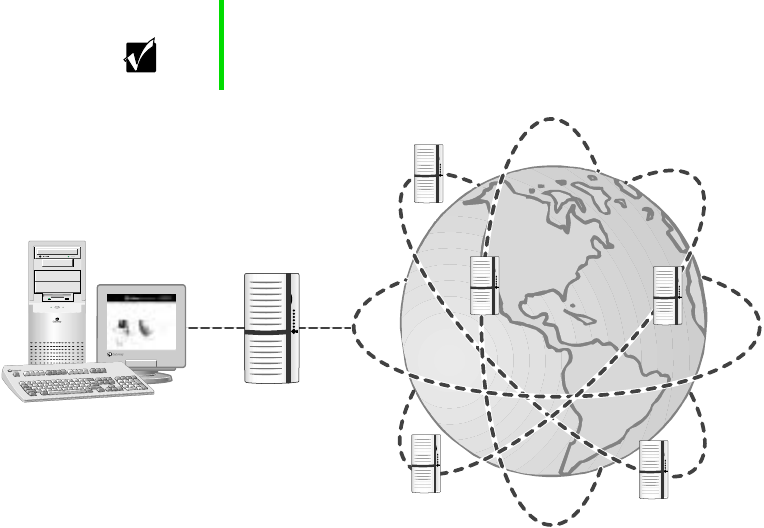
58
Chapter 5: Using the Internet
www.gateway.com
Learning about the Internet
The Internet is a worldwide network of computers linked together to provide
information to people everywhere. The two most popular services on the
Internet are e-mail and the World Wide Web. You can access this network by
connecting your computer to a telephone, DSL (Digital Subscriber Line), or
cable line and signing up with an Internet Service Provider (ISP).
Cable and DSL modems, a faster connection known as broadband, use your
TV cable or special telephone lines to connect to your ISP and access the
Internet. Cable and DSL modems connect to your computer through an
Ethernet jack.
Important For the location of your Ethernet jack, see “Left side” on
page 3.
Your computer
connects to the
Internet through
an ISP.
ISP Servers
let you connect to
the Internet and
access your e-mail
messages.
Internet Servers
store information so other
computers can access it
from the Internet.
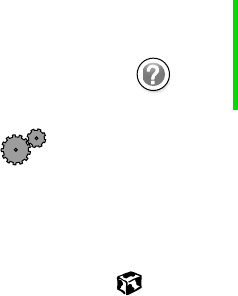
59
Setting up an Internet account
www.gateway.com
If you want to access the Internet you need:
■A modem – a device that connects your computer to other computers
or servers using a telephone, DSL, or cable line.
■An Internet Service Provider – a company that provides access to the
Internet through an ISP server. When you connect to an ISP, the ISP server
lets you access the Internet and your e-mail messages.
■A Web browser – a program that displays information from the World
Wide Web.
■An e-mail program – a program that lets you create, send, and receive
e-mail messages over the Internet.
Setting up an Internet account
Before you can view the information on the World Wide Web, you need to
set up an Internet account with an Internet Service Provider (ISP). If you have
chosen America Online as an ISP, follow these instructions to set up and
connect to your account. To establish a different ISP service, or to transfer an
existing account to this computer, contact the ISP directly.
If you set up an account with America Online, an Internet e-mail address is
created for you. After completing the setup you are ready to access the
Internet.
To set up an Internet account with America Online:
1Click Start, All Programs, then click America Online.
2Follow the on-screen instructions. After setting up your account, you can
connect to the Internet and access your e-mail services.
Help and
Support For more information on setting up and accessing an
Internet account, click Start, then click Help and Support.
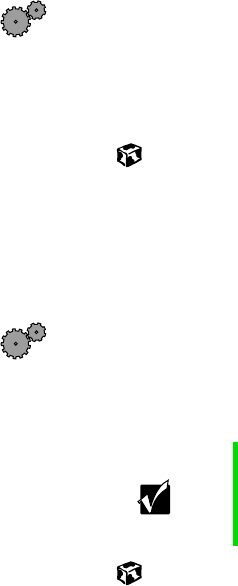
60
Chapter 5: Using the Internet
www.gateway.com
Accessing your Internet account
To connect to your America Online Internet account:
1Click Start, All Programs, then click America Online.
2Complete the member name and password information, then click
Connect. The computer dials the Internet account telephone number.
If you are using a service other than America Online, check with your ISP for
the correct procedure for connecting.
After connecting, the Web browser window opens. For information about the
Web and the Web browser, see “Using the World Wide Web” on page 61.
To disconnect from your America Online Internet account:
■Click X in the top right corner of the America Online window. Your
computer disconnects from the Internet.
If you are using a service other than America Online, check with your ISP for
the correct procedure for disconnecting.
Important Make sure that your computer disconnects correctly from
your Internet account. If you do not have an “unlimited
hours” ISP account, you may have to pay for the time that
you are connected, even if you are not at the computer.
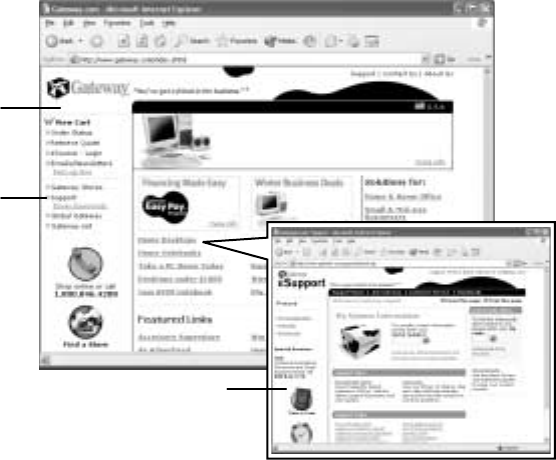
61
Using the World Wide Web
www.gateway.com
Using the World Wide Web
The World Wide Web is a multimedia window to the Internet that gives you
access to millions of information sources.
Information on the Web comes to you on Web pages, which are electronic
documents that you view using a Web page display program called a browser.
You can use any of the commercially available Web browsers, like Microsoft
Internet Explorer, which comes installed on your new computer.
Web pages can contain text, animations, music, and other multimedia
features.
A group of related Web pages is called a Web site. You can access Web sites to
shop, track investments, read the news, download programs, and much more.
You can explore a Web site or visit other Web sites by clicking areas on a Web
page called links or hyperlinks. A link may be colored or underlined text, a
picture, or an animated image. You can identify a link by moving the mouse
pointer over it. If the pointer changes to a hand, the item is a link.
To learn more about using the Web browser features, click Help in the menu
bar.
Web
page
Link
Linked Web page
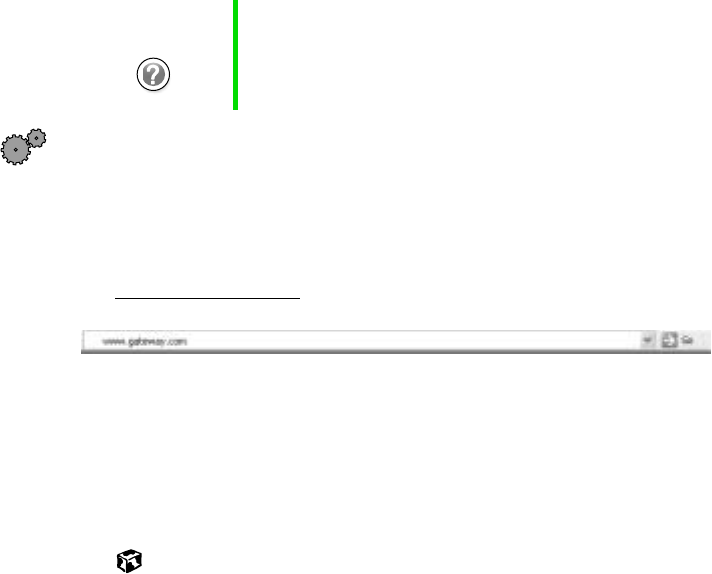
62
Chapter 5: Using the Internet
www.gateway.com
Connecting to a Web site
After you set up an account with an Internet Service Provider (ISP) such as
America Online, you can access the many information sources on the World
Wide Web.
To connect to a Web site:
1Connect to your Internet account. After the computer connects, a default
opening page or welcome screen opens.
2To go to a different Web site, type the address (called a URL for “Universal
Resource Locator”) in the browser address bar (for example
www.gateway.com), then click GO on the browser address bar.
- OR -
On the current Web page, click a link to a Web site.
The Web browser locates the server computer on the Internet, downloads
(transfers) data to your computer, and displays the page on the site that
you requested.
Sometimes Web pages display slowly. The speed that a Web page displays on
your screen depends on the complexity of the Web page and other Internet
conditions. Additionally, the speed of your connection will determine how
fast Web pages display.
Help and
Support For more information on connecting to a Web site in
Windows XP, click Start, then click Help and Support.

63
Using the World Wide Web
www.gateway.com
Downloading files
Downloading is the process of transferring files from a computer on the
Internet to your computer.
To protect your computer against viruses, make sure that you scan the files
you download. For more information, see “Protecting your computer from
viruses” on page 187.
To download files or programs from a Web site:
1Connect to your Internet account.
2In the address bar, type the address of the Web site that contains the file
or program you want to download, then click GO on the browser address
bar.
- OR -
Click a link on a Web page to navigate to the Web site containing the
file that you want to download.
3Create or locate the folder where you want to store the file on your
computer.
4Click the link on the Web page for the file that you want to download.
5Follow the on-screen instructions for saving the file in the folder that
you want.
A copy of the file is downloaded to your computer. The time that it takes
to transfer the file to your computer depends on file size and Internet
conditions.
6Open the folder that you created.
7Install or view the downloaded file by double-clicking it. If applicable,
follow the instructions provided on the Web site to run or install the
program.
Help and
Support For more information on downloading files in Windows XP,
click Start, then click Help and Support.
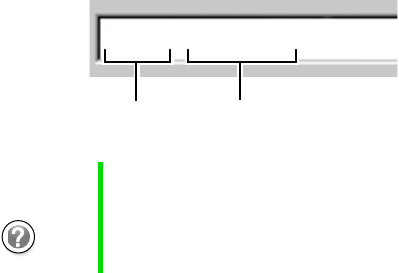
64
Chapter 5: Using the Internet
www.gateway.com
Using e-mail
E-mail (electronic mail) lets you send messages to anyone who has an Internet
connection and e-mail address. E-mail is usually a free service of your Internet
account.
The Internet never closes, so you can send e-mail messages at any time. Your
e-mail messages arrive at most e-mail addresses in minutes.
An e-mail address consists of a user name, the @ symbol, and the Internet
domain name of the Internet Service Provider (ISP) or company that “hosts”
that user. Your e-mail address is assigned when you sign up for an account
with an ISP. For example, a person with an account with America Online
might have an e-mail address that is similar to this one:
Help and
Support For more information on using e-mail in Windows XP, click
Start, then click Help and Support.
jdoe@aol.com
User name Internet domain name

65
Using e-mail
www.gateway.com
Sending e-mail
To send e-mail using America Online:
1Connect to your America Online account.
2Click Write.
3Type the e-mail address of the recipient you want to send e-mail to in
the Send To box.
4Type the subject of your e-mail in the Subject box.
5Type the e-mail message.
6When finished, click Send Now. Your e-mail is sent over the Internet to
the e-mail address you specified.
Checking your e-mail
To check your e-mail using America Online:
1Connect to your America Online account.
2Click Read.
3Double-click the message you want to read.
For more information about managing and organizing your e-mail messages,
see the online help in your e-mail program.
66
Chapter 5: Using the Internet
www.gateway.com

67
6
www.gateway.com
Using
Multimedia
This chapter provides information on using the multimedia capabilities of
your notebook. Read this chapter to learn how to:
■Use the diskette drive
■Use a CD, CD-RW, DVD, or combination DVD/CD-RW drive
■Create CDs
■Adjust the volume
■Play CDs and DVDs
■Record and play audio files
■Use Windows Media Player
■Use MusicMatch
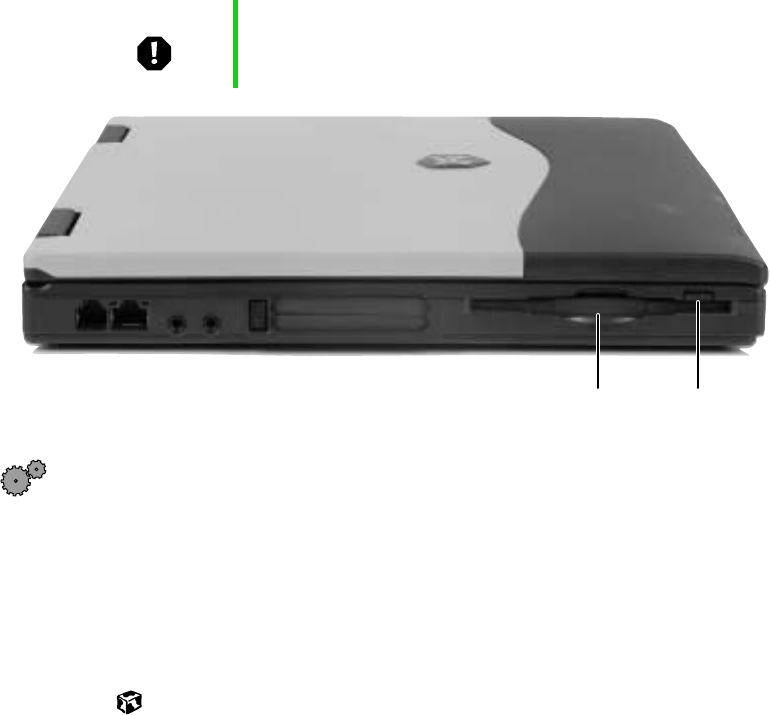
68
Chapter 6: Using Multimedia
www.gateway.com
Using diskettes
The diskette drive uses 3.5-inch diskettes (sometimes called floppy disks).
Diskettes are useful for storing files or transferring files to another computer.
To use a diskette:
1Insert the diskette into the diskette drive with the label facing up.
2To access a file on the diskette, click Start, My Computer, double-click the
drive letter (for example, the A: drive), then double-click the file name.
3To remove the diskette, make sure the diskette drive status indicator is
off (see “Status indicators” on page 17), then press the diskette eject
button.
Warning Do not expose diskettes to water or magnetic fields.
Exposure could damage the data on the diskette.
Diskette
slot Eject
button
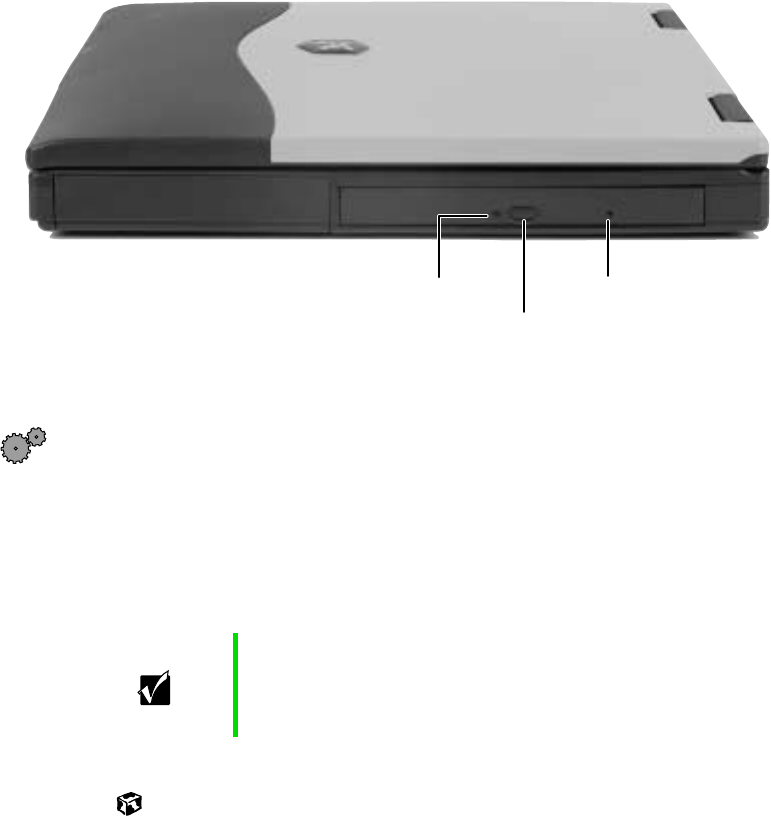
69
Using a CD, CD-RW, or DVD drive
www.gateway.com
Using a CD, CD-RW, or DVD drive
You can use your computer to enjoy a wide variety of multimedia features,
such as making recordings, listening to audio CDs, and watching DVD movies.
Inserting a CD, CD-RW, or DVD
To insert a CD, CD-RW, or DVD:
1Press the eject button on the CD, CD-RW, DVD, or combination
DVD/CD-RW drive. After the tray opens slightly, pull the disc tray
completely open.
2Place the disc in the tray with the label facing up, then press down
carefully on the disc until it snaps into place.
3Push the tray in until it is closed.
Important When you place a single-sided disc in the tray, make sure
that the label side is facing up. If the disc has two playable
sides, place the disc so that the name of the side you want
to play is facing up.
Eject button
Activity indicator Manual eject hole
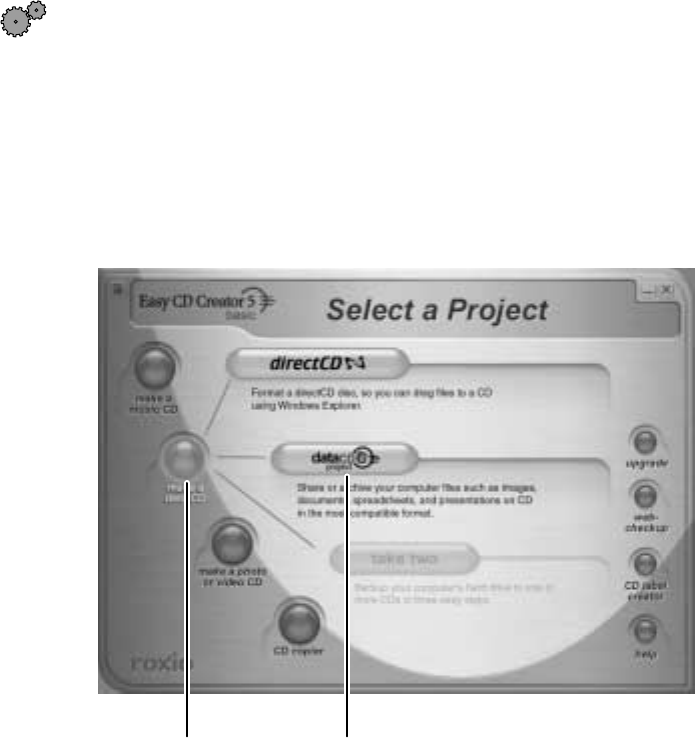
70
Chapter 6: Using Multimedia
www.gateway.com
Creating CDs using your CD-RW or
DVD/CD-RW drive
Creating data CDs
Use Roxio Easy CD Creator to create data CDs. Data CDs are ideal for backing
up important files such as tax records, letters, MP3s, or photos.
To create a data CD:
1Insert a blank CD-R or CD-RW disc into your CD-RW drive.
2If a CD Drive dialog box opens, click Create a CD using Roxio Easy CD
Creator, then click OK. The Project Selector window opens.
- OR -
If a dialog box does not open, click Start, All Programs, Roxio Easy CD
Creator, then click Project Selector. The Project Selector window opens.
make a data CD dataCD project
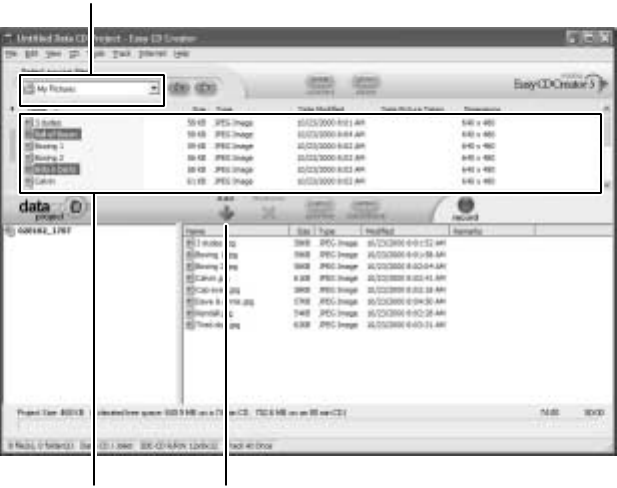
71
Creating CDs using your CD-RW or DVD/CD-RW drive
www.gateway.com
3Move your pointer over make a data CD, then click dataCD project. The
Easy CD Creator window opens.
4Click the arrow button to open the Select Source Files list, then click the
folder where your files are located.
Source Pane Add
Select Source Files
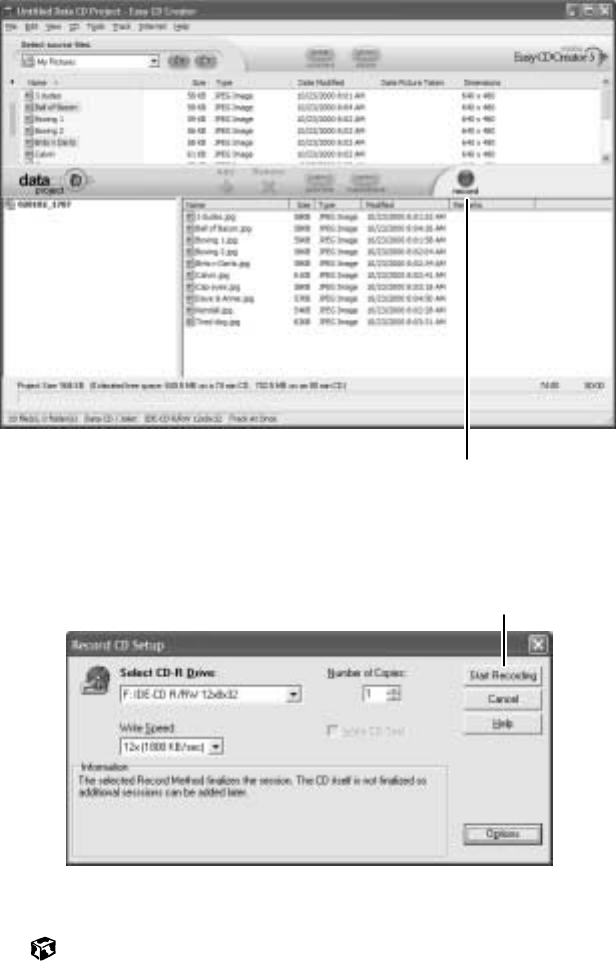
72
Chapter 6: Using Multimedia
www.gateway.com
5Click the file you want to record (hold down the CTRL or SHIFT key when
you click to select multiple files) in the Source pane, then click Add.
6After you have added all of your files, click record. The Record CD Setup
window opens.
7Click Start Recording.
record
Start Recording
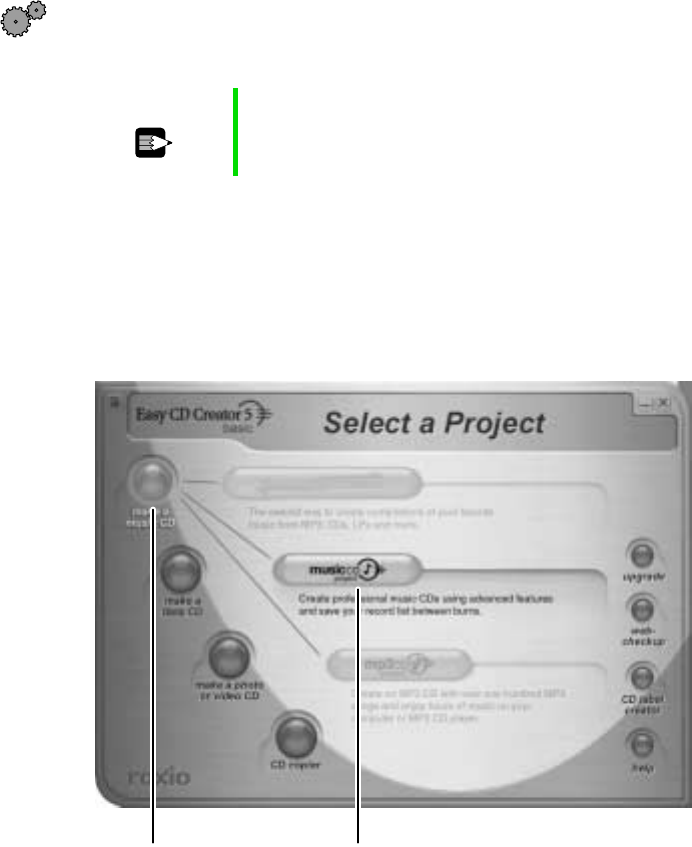
73
Creating CDs using your CD-RW or DVD/CD-RW drive
www.gateway.com
Creating music CDs
Use Roxio Easy CD Creator to create music CDs from other music CDs or MP3
files.
To create music CDs:
1Insert a blank CD-R or CD-RW disc into your CD-RW drive.
2If a CD Drive dialog box opens, click Create a CD using Roxio Easy CD
Creator, then click OK. The Project Selector window opens.
- OR -
If a dialog box does not open, click Start, All Programs, Roxio Easy CD
Creator, then click Project Selector. The Project Selector window opens.
Tips & Tricks Most car stereos read CD-R discs, but do not read CD-RW
discs.
make a music CD musicCD project
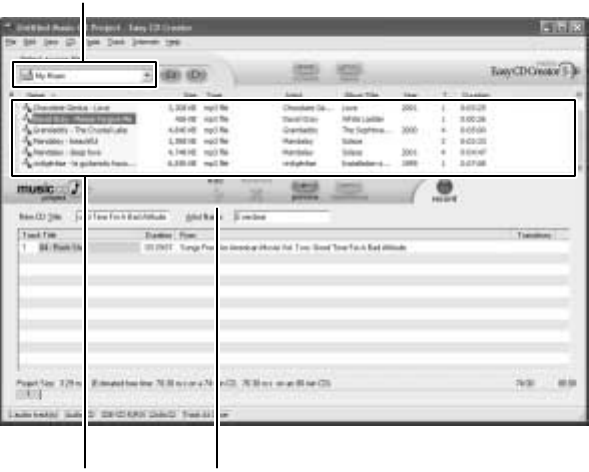
74
Chapter 6: Using Multimedia
www.gateway.com
3Move your pointer over make a music CD, then click musicCD project. The
Easy CD Creator window opens.
4Click the arrow button to open the Select Source Files list, then click the
folder where your files are located.
Source pane Add
Select Source Files
Source pane
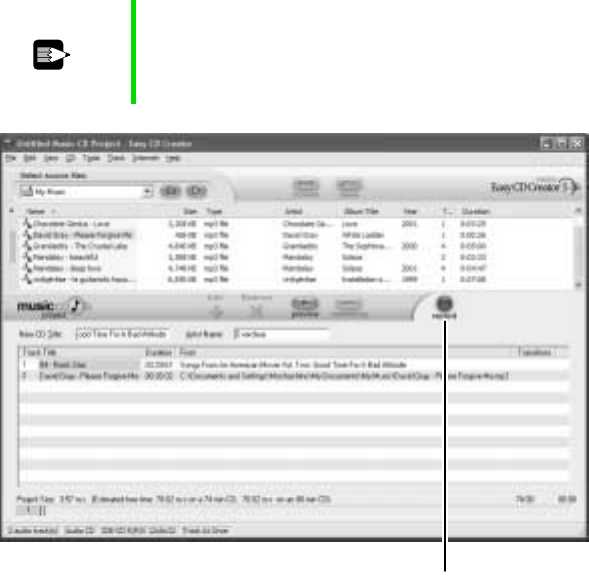
75
Creating CDs using your CD-RW or DVD/CD-RW drive
www.gateway.com
5Click the file you want to record (hold down the CTRL or SHIFT key when
you click to select multiple files) in the Source pane, then click Add.
Tips & Tricks You can add any combination of music tracks or MP3 files
to a music CD project. You can add up to 99 tracks and
files, or up to 650 MB (74-minute CD) or 700 MB
(80-minute CD) of tracks and files to a music CD project.
record
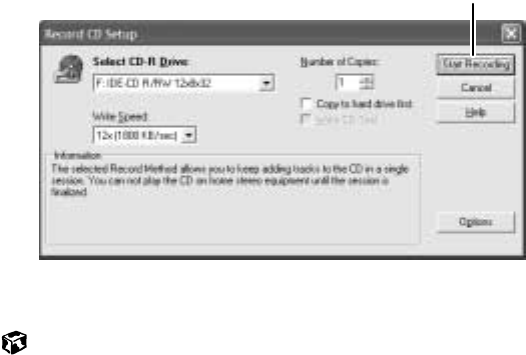
76
Chapter 6: Using Multimedia
www.gateway.com
6After you have added all of your tracks and files, click record. The Record
CD Setup window opens.
7Click Start Recording.
Start Recording
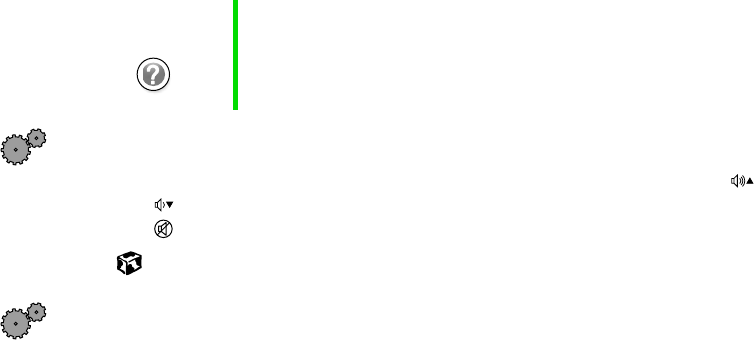
77
Adjusting the volume
www.gateway.com
Adjusting the volume
You can use the volume controls to adjust the overall volume and the volume
of specific sound devices in your computer.
To adjust the overall volume level using hardware controls:
■On the keyboard, press the volume system key combination FN+ or
FN+ to change the volume, or press the mute system key combination
FN+ to turn off all sound.
To adjust the overall volume level from Windows:
1Click Start, then click Control Panel. The Control Panel window opens. If
your Control Panel is in Category View, click Sounds, Speech, and Audio
Devices.
2Click/Double-click the Adjust the system volume or Sounds and Audio
Devices. The Sounds and Audio Devices Properties dialog box opens.
Help and
Support For more information about adjusting the volume in
Windows XP, click Start, then click Help and Support.
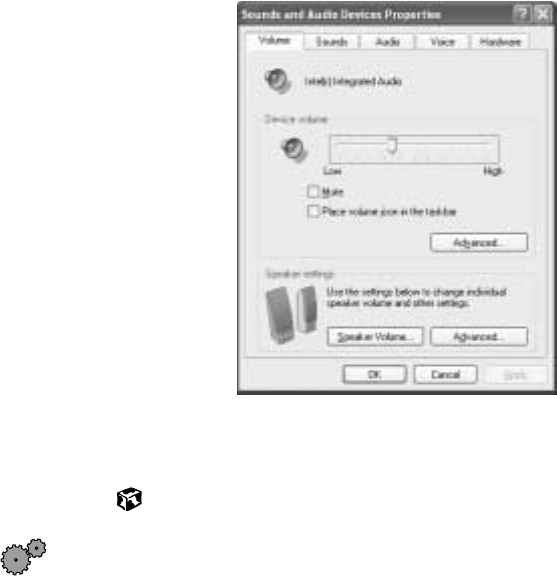
78
Chapter 6: Using Multimedia
www.gateway.com
3Click the Volume tab.
4Drag the Device Volume slider to change the volume or click to select the
Mute check box, then click OK.
To adjust specific volume levels:
1Click Start, then click Control Panel. The Control Panel window opens. If
your Control Panel is in Category View, click Sounds, Speech, and Audio
Devices.
2Click/Double-click the Adjust the system volume or Sounds and Audio
Devices. The Sounds and Audio Devices Properties dialog box opens.
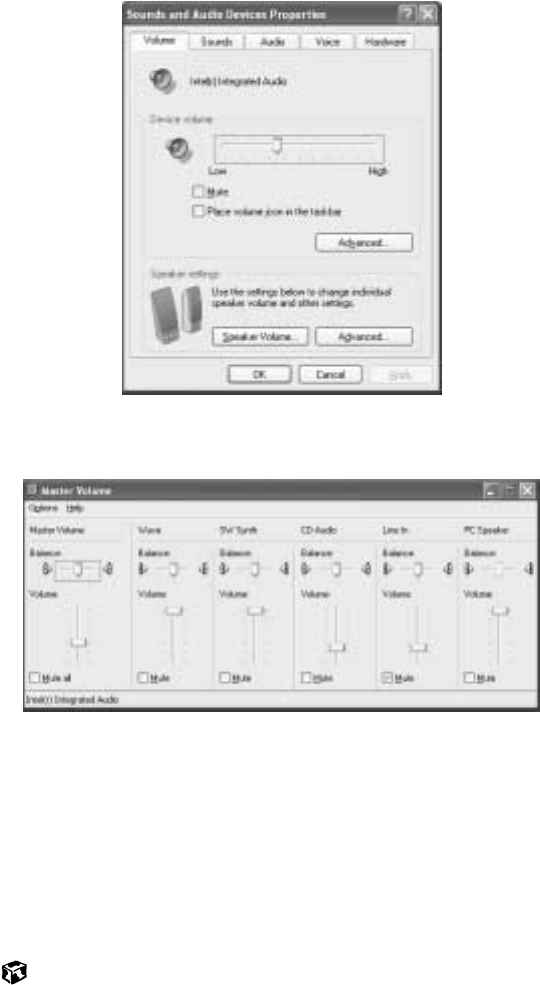
79
Adjusting the volume
www.gateway.com
3Click the Volume tab.
4Click Advanced in the Device volume area.
If the device you want to adjust does not appear in the window, click
Options, Properties, the check box next to the audio device you want to
appear, then click OK.
5Drag the volume level and balance sliders for the device you want to
adjust, then close the window. For more information about the volume
controls, click Help in the window.
6Click X in the top-right corner of the window to close it.
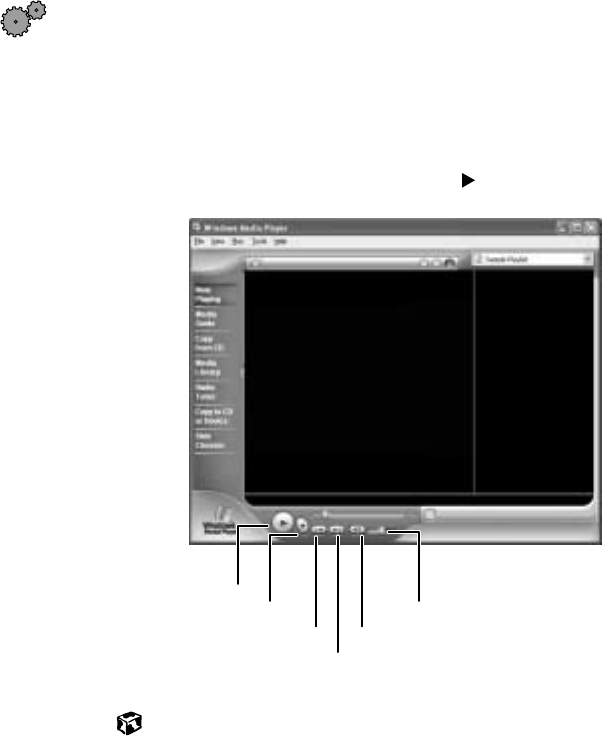
80
Chapter 6: Using Multimedia
www.gateway.com
Listening to CDs
Use the Windows Media Player to listen to CDs. For more information about
the using the Windows Media Player, click Help. You can also use MusicMatch
to listen to CDs. See “Using MusicMatch” on page 85 for more information.
To play a CD:
1Insert a CD into the CD, CD-RW, DVD, or combination DVD/CD-RW
drive.
2If a message asks you to chose a CD player, click Windows Media Player.
The Windows Media Player opens.
3When the media player opens, click (play).
Play Stop
Next
Previous Mute
Volume
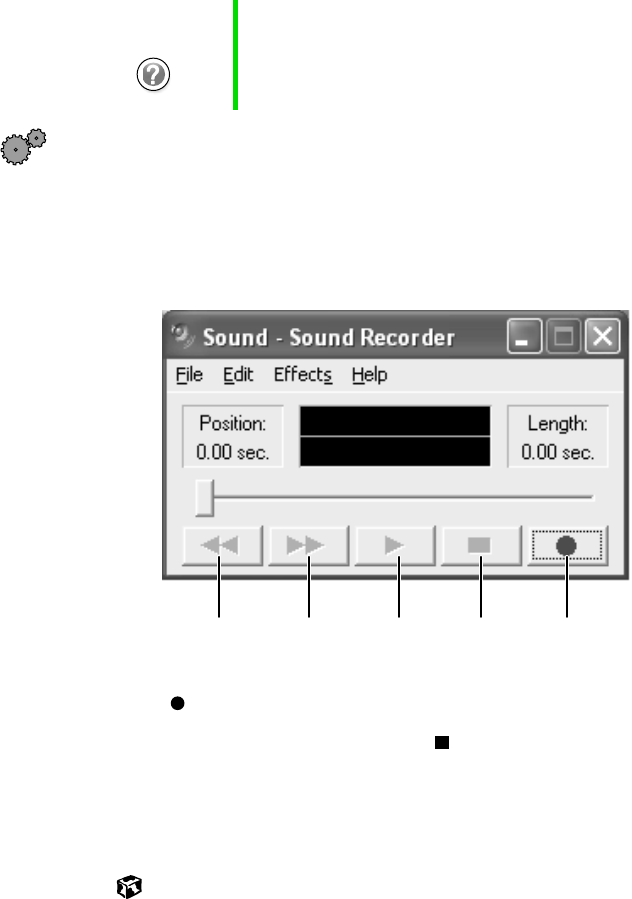
81
Recording and playing audio
www.gateway.com
Recording and playing audio
Use the instructions below to make an audio recording by speaking into the
microphone.
To make an audio recording:
1Plug a microphone into the Microphone jack on your computer. See “Left
side” on page 3 for the location of the Microphone jack.
2Click Start, All Programs, Accessories, Entertainment, then click Sound
Recorder. The Sound Recorder opens.
3Click (record), then speak into the microphone.
4When you finish recording, click (stop).
5Click File, then click Save As. The Save As dialog box opens.
6Name the recording, specify the location where you want to save the
recording, then click Save. The recording is saved.
Help and
Support For more information about recording and playing audio in
Windows XP, click Start, then click Help and Support.
Rewind Fast
Forward Play Stop Record
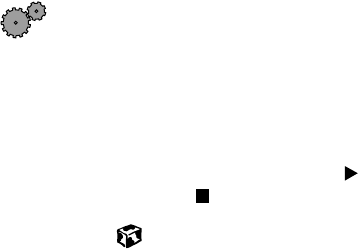
82
Chapter 6: Using Multimedia
www.gateway.com
To play an audio recording in Sound Recorder:
1Open the Sound Recorder.
2Click File, then click Open. The Open dialog box opens.
3Click the file you want to play, then click Open.
4Play the file by clicking (play), then stop playing the file by
clicking (stop).
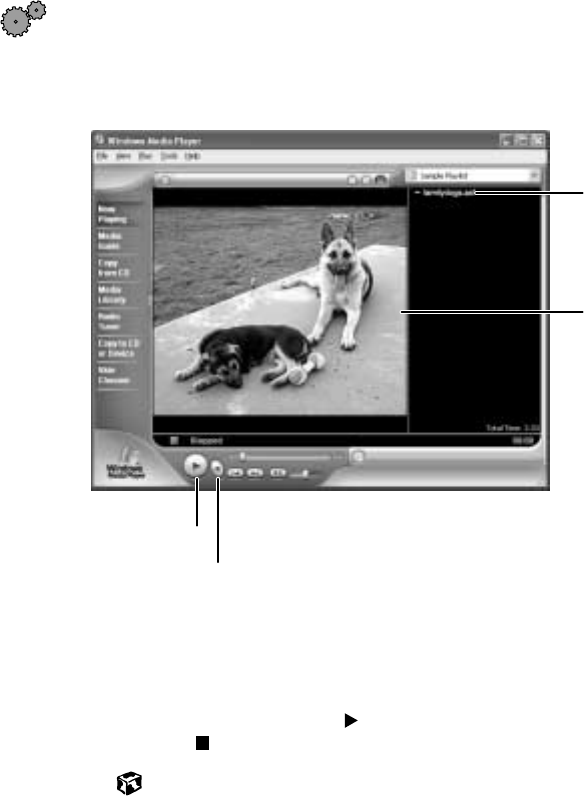
83
Recording and playing audio
www.gateway.com
Playing audio and video files with the
Windows Media Player
The Windows Media Player can play several types of audio and video files,
including WAV, MIDI, MP3, AU, AVI, and MPEG formats. For more
information about using the Windows Media Player, click Help.
To play a file using the Windows Media Player:
1Click Start, All Programs, then click Windows Media Player.
The Windows Media Player opens.
2Click File, then click Open. The Open dialog box opens.
3Click the file you want to play, then click Open.
4Play the file by clicking (play), then stop playing the file by
clicking (stop).
Video file
information
Video
screen
Stop
Play
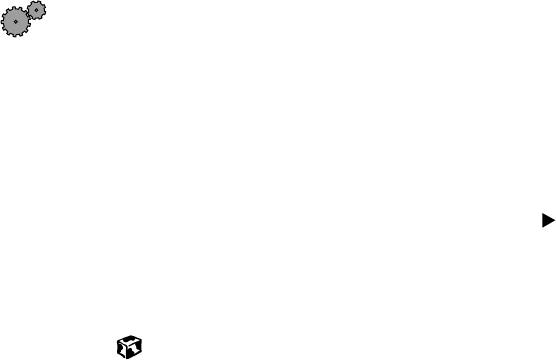
84
Chapter 6: Using Multimedia
www.gateway.com
Playing a DVD
A Digital Versatile Disc (DVD) is similar to a standard CD but has greater data
capacity. Because of this increased capacity, full-length movies, several albums
of music, or several gigabytes of data can fit on a single disc. If your computer
has a DVD drive or combination DVD/CD-RW drive, you can play DVDs with
the DVD Player program. For more information about playing DVDs, click
Help in the DVD player program.
To play a DVD:
1Make sure that the speakers are turned on or headphones are plugged in
and that the volume is turned up.
2Turn off your screen saver and standby timers.
3Click Start, All Programs, DVD Player, then click DVD Player. The DVD Player
video screen and control panel open.
4Insert a DVD into the DVD drive, then click (play). The DVD plays.
5To specifically control the DVD or adjust the volume, use the controls
in the DVD player. For more information on using the DVD player, see
its online help.
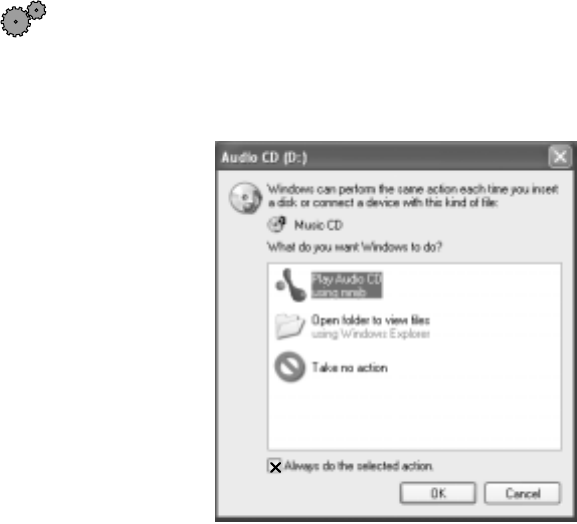
85
Using MusicMatch
www.gateway.com
Using MusicMatch
Using MusicMatch™, you can:
■Play music CDs
■Create MP3 music files from your music CDs
■Use your music files to build a music library
■Enter music track information
■Listen to Internet Radio
For more information on using MusicMatch, see its online Help.
Playing CDs
You can use the MusicMatch program to play music CDs.
To play a music CD:
1Insert the music CD into the CD, CD-RW, DVD, or combination
DVD/CD-RW drive on your computer. The first time you insert a CD, the
Audio CD dialog box opens.
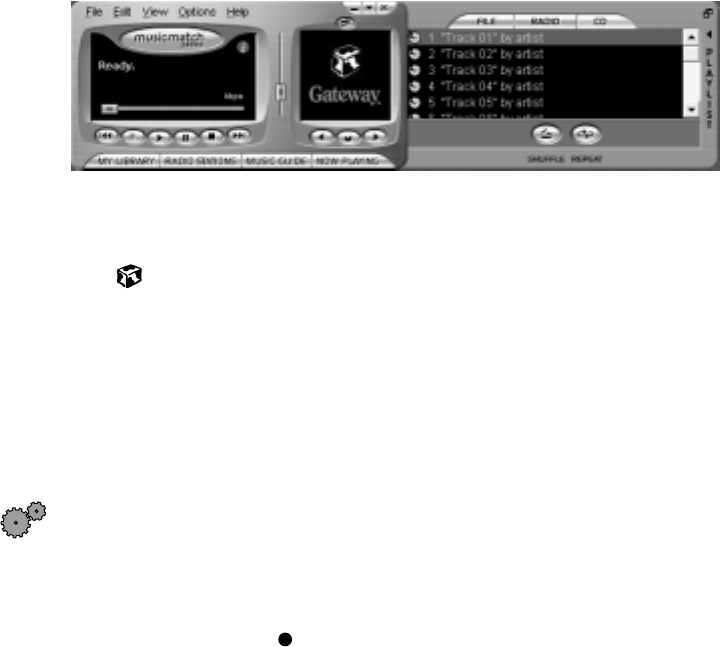
86
Chapter 6: Using Multimedia
www.gateway.com
2Click Play Audio CD using MUSICMATCH Jukebox, click Always do the selected
action, then click OK. MusicMatch opens, the CD begins playing, and the
names of the music tracks appear in the playlist area.
The next time you insert an audio CD, MusicMatch plays the CD
automatically.
Creating music files
Using MusicMatch, you can copy the tracks from a music CD to your
computer’s hard drive as MP3 files. MP3 (MPEG Layer 3) is a standard for
digitally compressing high-fidelity music into compact files without
noticeably sacrificing quality. MP3 files end in the file extension .mp3.
To create (rip) MP3 files:
1Open MusicMatch by clicking Start, All Programs, MusicMatch, then
clicking MusicMatch Jukebox.
2Insert a CD into the CD, CD-RW, DVD, or combination DVD/CD-RW
drive, then click (record). The Recorder window opens.
3By default all tracks in the track list are selected. Clear the checkbox of
any audio track you do not want to record (rip).
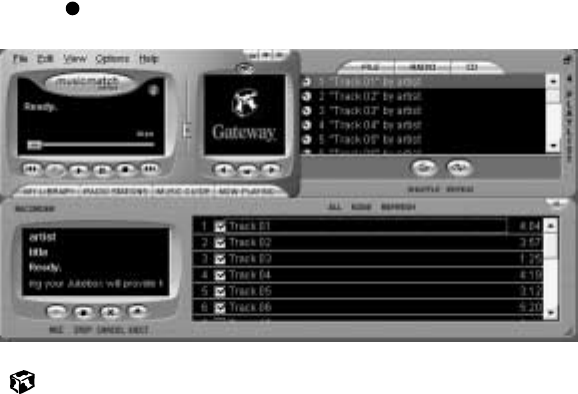
87
Using MusicMatch
www.gateway.com
4Click (REC), then follow the on-screen instructions.
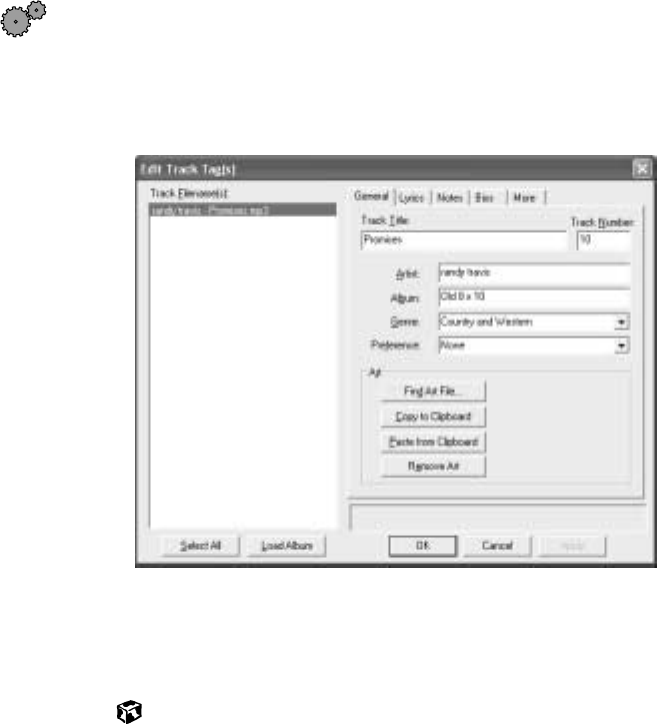
88
Chapter 6: Using Multimedia
www.gateway.com
Editing track information
After you add a CD track as an MP3 file to your music library, you can edit
the track’s information.
To edit track information:
1In MusicMatch, click My Library. The library window opens.
2In the library window, right-click the file, then click Edit Track Tag(s). The
Edit Track Tag dialog box opens.
3Enter information such as track title, lead artist, album, and genre.
4Click OK. The new track information appears in the MusicMatch playlist,
music library, and recorder.
89
Using MusicMatch
www.gateway.com
Building a music library
Use MusicMatch to build a music library. You can organize your music tracks
by categories, find a track quickly by using the sort features, and add
information to a music file.
You can add music tracks to your music library by:
■Creating MP3 files – When you create MP3 files from the tracks on your
music CD, MusicMatch automatically adds these files to your music
library.
■Dragging and Dropping – Drag and drop files from Windows Explorer
or your desktop to the music library.
■Downloading files from the Internet – When you are connected to the
Internet, MP3 files that you download are automatically added to your
music library.
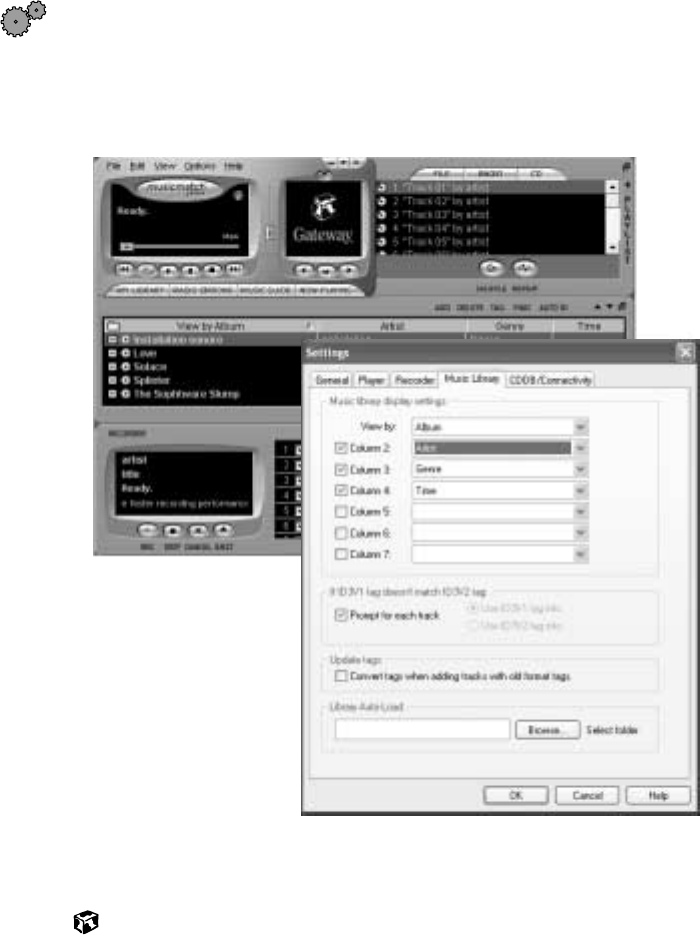
90
Chapter 6: Using Multimedia
www.gateway.com
Changing the music library display settings
To change the music library display settings:
1In MusicMatch, click Options, then click Settings. The Settings window
opens.
2Click the Music Library tab.
3Click the categories that you want to display in the columns, then
click OK.
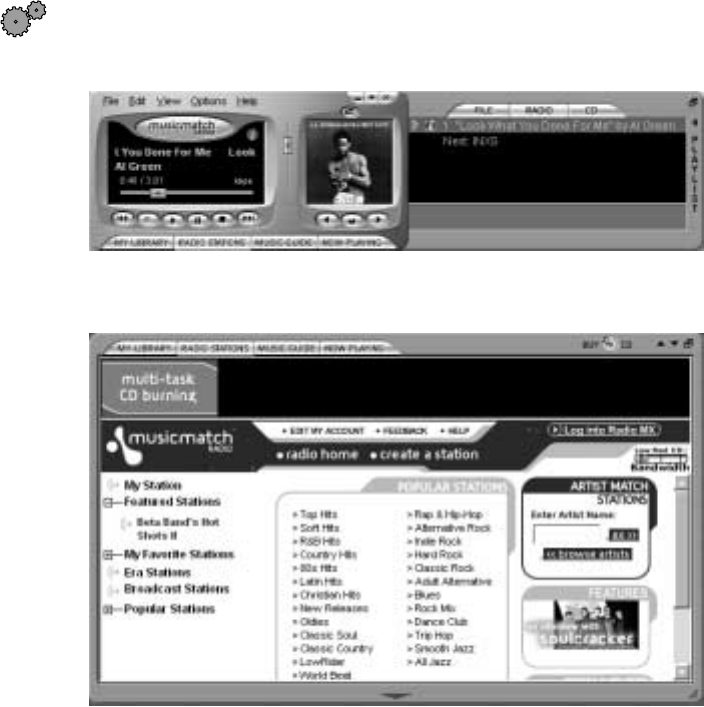
91
Using MusicMatch
www.gateway.com
Listening to Internet radio
Use the Radio feature in MusicMatch to listen to Internet Radio stations.
To listen to an Internet radio station:
1Connect to the Internet, then open MusicMatch.
2Click Radio Stations. The Radio window opens.
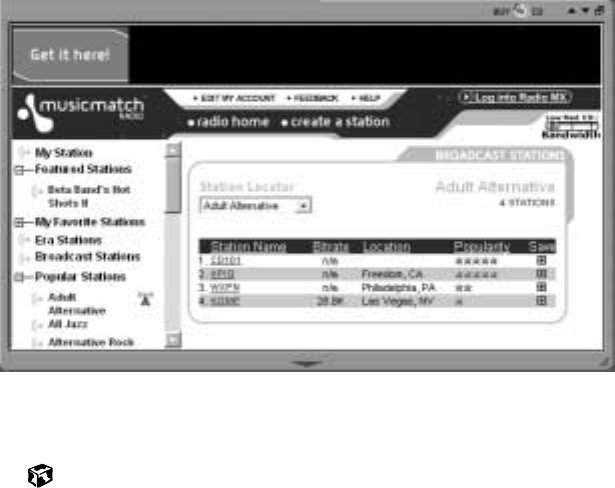
92
Chapter 6: Using Multimedia
www.gateway.com
3To select one of the MusicMatch Internet radio stations, click one of the
Popular Stations. You can also choose another Internet radio station by
clicking Broadcast Stations, then clicking the appropriate category in the
Station Selector.
4Select a radio station, then click Play. MusicMatch connects to the station
and plays the audio.
Using advanced features
You can also use MusicMatch to create your own music CDs and to download
MP3 files to your portable MP3 player. For more information, see the
MusicMatch online Help.
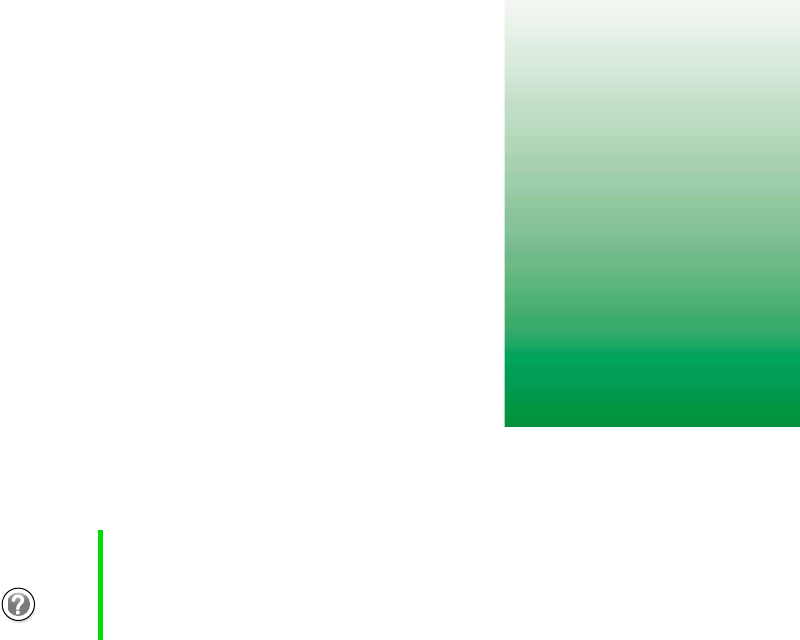
93
7
www.gateway.com
Sending and
Receiving
Faxes
PhoneTools lets you send and receive faxes using the modem.
Before you send your first fax, you need to set up your user information. Your
fax cover sheets and fax headers will contain this information, which is
required by law.
Help and
Support For more information about using the fax functions in
Windows XP, click Start, then click Help and Support.
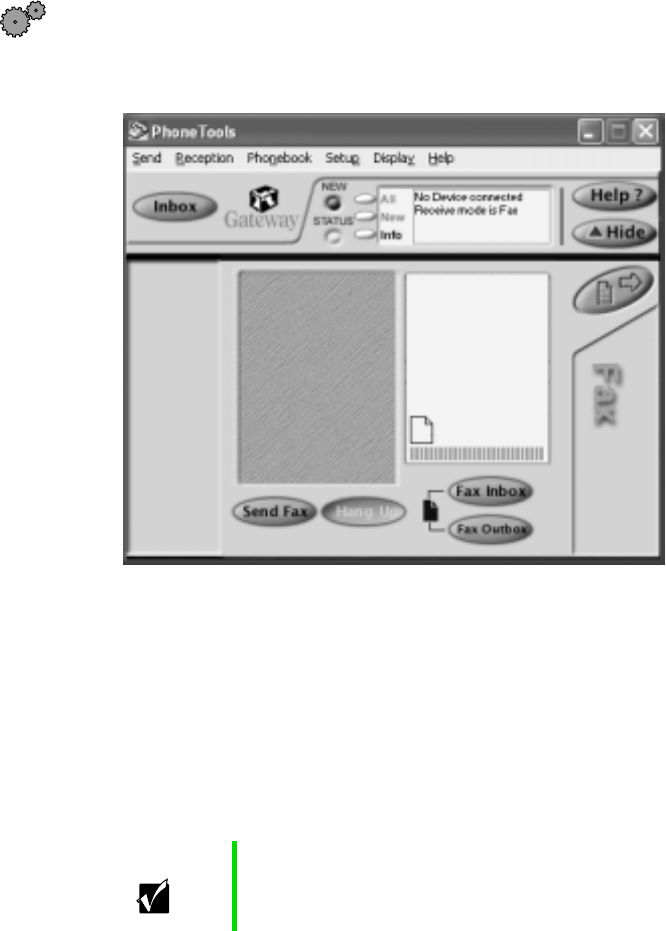
94
Chapter 7: Sending and Receiving Faxes
www.gateway.com
Setting up your cover page
To set up your fax cover page:
1If PhoneTools is not open, click Start, All Programs, PhoneTools, then click
PhoneTools.
2Click Setup, then click General Setup. The General Setup dialog box opens.
3Click the Customize tab, then type your personal information in the User
boxes.
4Click the Fax tab, then enter your name and fax number in the Fax
identifier text box. This identifier information is required by law. You can
enter up to 20 characters in the text box. We suggest using eight
characters for your identifier name, followed by 12 characters for your
telephone number.
5Click OK.
Important Some fax machines cannot use special characters such
as hyphens. We suggest using spaces instead of hyphens
in telephone and fax numbers.
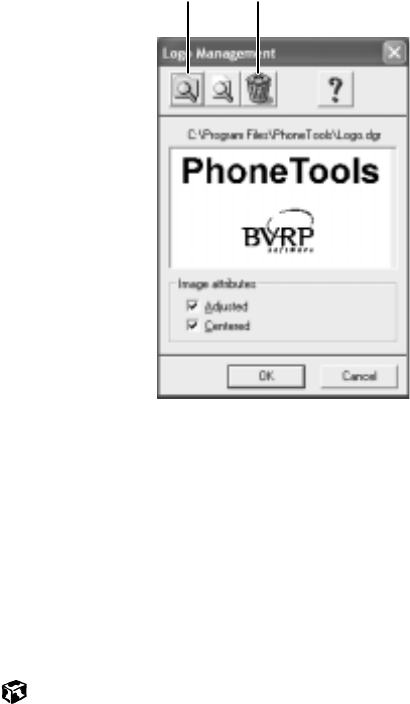
95
Setting up your cover page
www.gateway.com
6If you want to change the logo that appears on the cover page, click Setup,
then click Logo Management. The Logo Management dialog box opens.
7If you do not want the PhoneTools logo on your cover page, click the
picture then click the clear button.
- OR -
If you want to replace the PhoneTools logo with one of your own, click
the import button then select a picture for the logo. The picture must
be saved in a supported format (.BMP, .DGR, .GIF, .JPG, .PCX, .T31, or
.TIF) and be small enough to fit in the logo box.
8Click OK.
Import
button Clear
button
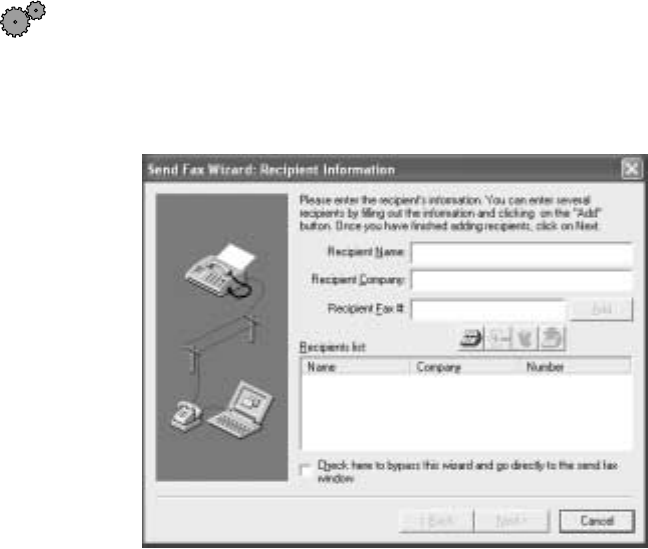
96
Chapter 7: Sending and Receiving Faxes
www.gateway.com
Sending a fax
To send a fax:
1If PhoneTools is not open, click Start, All Programs, PhoneTools, then click
PhoneTools.
2Click Send Fax. The Send Fax Wizard opens.
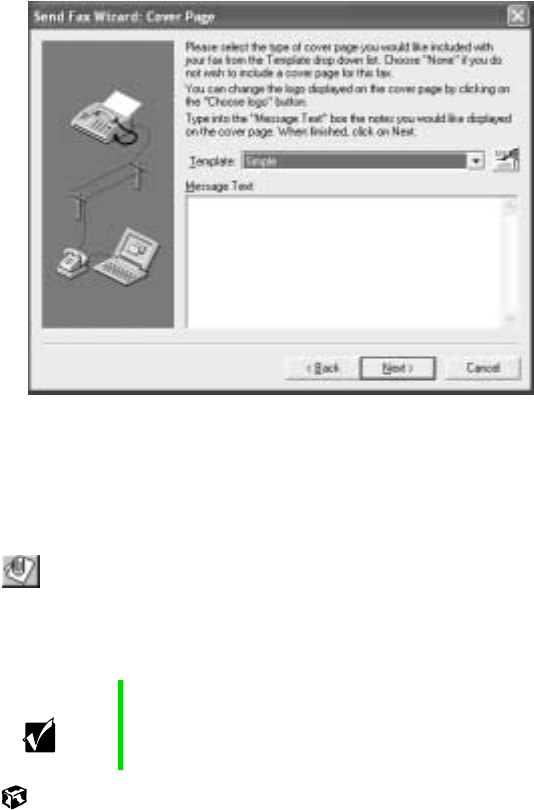
97
Sending a fax
www.gateway.com
3Enter the recipient’s name, company (if applicable), and fax number, then
click Next.
4Type the message text in the Message Text area.
5Select a cover page template from the Template list, then click Next. If you
typed a message in the Message Text area, you must select a cover page.
6If you want to attach a file, make sure the file is not open, then click
(browse), click the file, then click Open.
7Click Next, then click Finish. The Confirm Transmissions dialog box opens.
8Click Send. PhoneTools dials the fax number and sends your fax.
Important If for any reason you receive a failed transmission
message, click Send, then click Outbox. Right-click the fax
that was not sent to modify it.

98
Chapter 7: Sending and Receiving Faxes
www.gateway.com
Faxing from programs
To fax a document directly from most programs:
1In the program with the document open, click File, then click Print. The
Print dialog box opens.
2Click the arrow button to open the Name list, click the printer CAPTURE
FAX BVRP, then click OK. The Send Fax Wizard opens.
3Complete the wizard as instructed in “Sending a fax” on page 96.
Receiving and viewing a fax
To receive and view a fax:
1If PhoneTools is not open, click Start, All Programs, PhoneTools, then click
PhoneTools.
When PhoneTools is open, it detects incoming faxes and stores them in
the In Box.
2To view a fax, click Fax Inbox, then double-click the fax you want to view.
The fax viewer opens, where you can view and print the fax.

99
8
www.gateway.com
Managing
Power
While your notebook is running on battery power, you should manage power
consumption to get the most use out of the battery. This chapter shows you
how to:
■Check and recharge the battery
■Recalibrate the battery
■Change batteries
■Extend the life of the battery by conserving battery power and using
alternate power sources
■Change power-saving settings
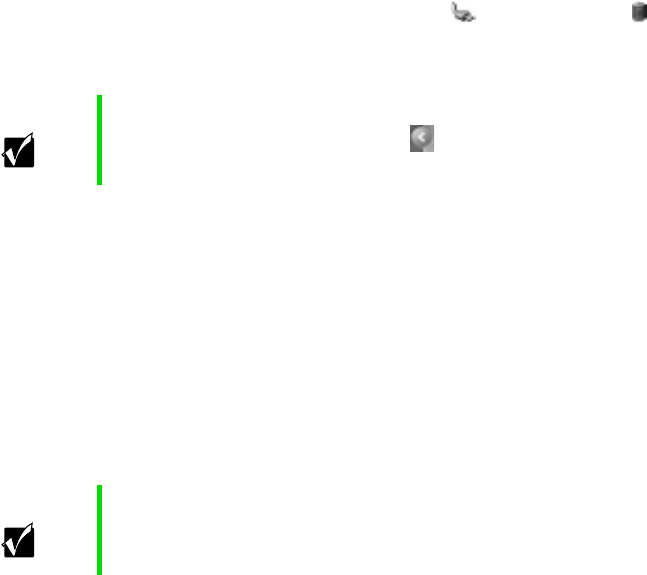
100
Chapter 8: Managing Power
www.gateway.com
Monitoring the battery charge
Closely monitor the battery charge. When the battery charge gets low, change
the battery or connect to AC power immediately to prevent losing any
unsaved work.
Monitor the battery charge by:
■Positioning the pointer over the power cord icon or battery icon
in the taskbar. A battery status window opens. Move the pointer away
from the icon to close the window.
■Pressing FN+STATUS to view the Status display, which opens in the upper
left corner of the screen. The Status display shows the current power
source, the battery charge, and the power management mode.
■Looking at the battery charge indicator:
■LED green – battery is fully charged.
■LED orange – battery is charging.
■LED red – battery is low.
■LED blinking and red – battery is very low.
■Waiting for a Low Battery warning message to appear.
If your battery charge indicators display what looks like an inaccurate charge,
you may need to recalibrate the battery. For more information, see
“Recalibrating the battery” on page 102.
Important If the power cord or battery icon does not appear on the
taskbar, click the show hidden icons button.
Important This LED only lights up when the notebook is plugged in.

101
Recharging the battery
www.gateway.com
Recharging the battery
The battery recharges while it is installed and your notebook is connected to
AC power. While the battery is recharging, the battery indicator turns orange
and the battery icon in the taskbar has a lightning bolt .
Important If the power cord or battery icon does not appear on the
taskbar, click the show hidden icons button.
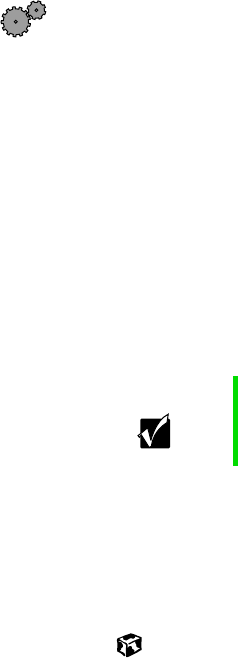
102
Chapter 8: Managing Power
www.gateway.com
Recalibrating the battery
If your notebook unexpectedly goes into Standby mode while you are using
it but the battery charge is not low, you may need to recalibrate your battery.
You should also recalibrate the battery once a year to maintain the accuracy
of the battery gauge.
To recalibrate the battery:
1Connect the AC adapter, then turn on your notebook.
2As soon as it starts and you see a startup screen, press F2. The BIOS Setup
program opens.
3Open the Power menu.
4Highlight Battery Calibration, then select Enabled by pressing the spacebar.
5Open the Exit menu, then highlight Exit Saving Changes and press ENTER.
6Select Yes, then press ENTER.
The battery learning process begins and a screen opens showing you the
progress. The entire process will take several hours.
When the recalibration has finished, the message “Press [Esc] key to exit”
appears.
7Press ESC. The battery indicator now displays the accurate battery charge.
If the battery indicator does not show an accurate charge, contact
Gateway Technical Support.
Important Do not interrupt the battery recalibration process. If
recalibration is interrupted, you must start the process over
again.
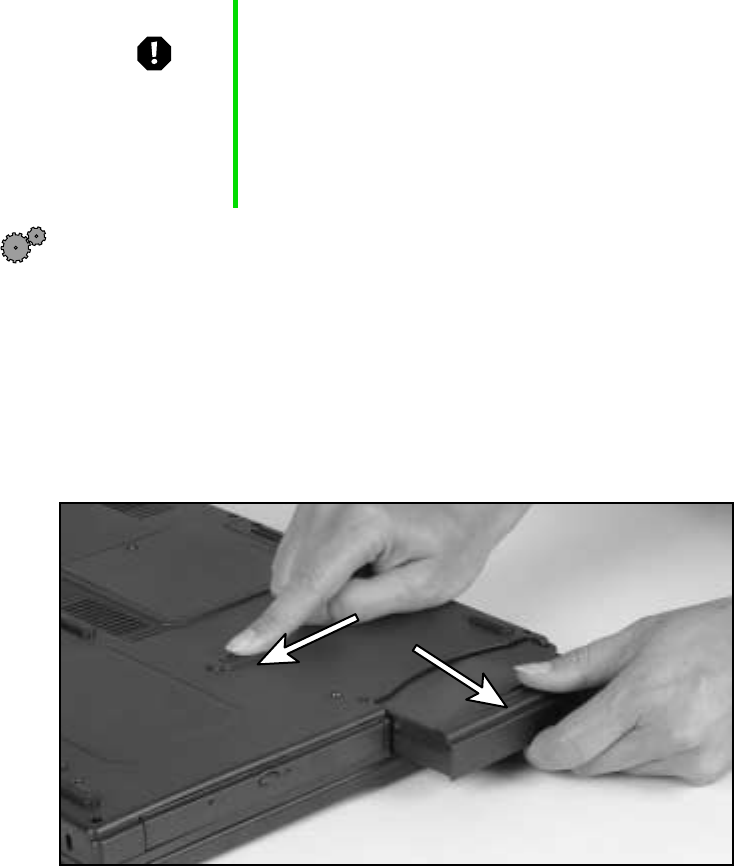
103
Changing batteries
www.gateway.com
Changing batteries
If your notebook is plugged into an AC outlet, you can change the battery
while the notebook is turned on. If your notebook is not plugged into an AC
outlet, you must turn it off while changing the batteries.
To replace the battery:
1If your notebook is on and is plugged into an AC outlet, go to step 2.
-OR-
If your notebook is on and is not plugged into an AC outlet, save your
work and turn off the notebook.
2Close the LCD panel and turn your notebook over.
3Slide the battery release latch and slide the battery out of the bay.
Warning Danger of explosion if battery is incorrectly replaced.
Replace only with the Gateway Solo 1450 Li-Ion or Ni-MH
battery. Discard used batteries according to the
manufacturer’s instructions.
The battery used in this device may present a fire or
chemical burn hazard if mishandled. Do not disassemble,
heat above 212°F (100°C), or incinerate. Dispose of used
battery promptly. Keep away from children.

104
Chapter 8: Managing Power
www.gateway.com
4Slide a charged battery into the bay until it snaps into place.
105
Extending battery life
www.gateway.com
Extending battery life
Conserving battery power
While using the battery to power your notebook, conserve power by:
■Removing PC Cards when you do not need them. Many PC Cards use a
small amount of power while inserted, even if they are not being used.
■Modifying the Power Management settings for maximum power savings.
For more information, see “Changing power settings” on page 107.
■Closing the LCD panel to turn off the display while you are not using
your notebook. The display stays off until you open the panel again.
■Using Hibernate mode for maximum power savings while the notebook
is not in use. For more information, see “Activating and Using Hibernate
Mode” on page 111.
■Using the CD, DVD, CD-RW, or combination DVD/CD-RW drives only
when necessary. These drives use a large amount of power.
■Recharge the battery often, take an extra battery, and fully recharge the
batteries before traveling. For more information, see “Recharging the
battery” on page 101 and “Changing batteries” on page 103.
Using alternate power sources
To extend battery life, use alternate power sources whenever possible.
■If traveling internationally, take electrical adapters. Save the battery for
times when you cannot use a power adapter. If you plan on taking your
AC adapter, also take a single-plug power surge protector.
■If you will have access to an EmPower™ in-flight power receptacle or an
automobile cigarette lighter, use an airplane/automobile power adapter.
Save the battery for times when you cannot use a power adapter.
■To find AC power outlets in airports, look for them next to support pillars,
in large areas such as boarding gates, and under banks of telephones.

106
Chapter 8: Managing Power
www.gateway.com
Changing power modes
You can use the following power modes to lengthen the life of your notebook’s
battery:
■Standby - while your notebook is in Standby, it switches to a low power
state where devices, such as the display and drives, turn off.
■Hibernate - (also called save to disk) writes all current memory (RAM)
information to the hard drive, then turns your notebook completely off.
The next time you turn on the notebook, it reads the memory
information from the hard drive and opens the programs and documents
that were open when you activated Hibernate. For more information on
using Hibernate mode, see “Activating and Using Hibernate Mode” on
page 111.
Using Standby mode
Always save your work before using Standby mode. When in Standby, your
computer reduces or turns off the power to most devices except memory.
However, the information in memory is not saved to the hard drive. If power
is interrupted, the information is lost.
When in Hibernate mode, your computer saves all memory information to
the hard drive, then turns the power completely off.
If your computer
is... ...and you
want to... ...then
On Enter
Standby mode Press FN+STANDBY.
On Enter Hibernate
mode (must be
enabled)
Click Start, Turn Off Computer, then
press and hold SHIFT and click
Hibernate.
In Standby or
Hibernate mode Exit Standby or
Hibernate mode Press the power button.
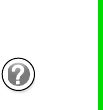
107
Changing power settings
www.gateway.com
Changing power settings
You can change the function of the power button, Standby key, and
power-saving timers by changing power settings on your notebook.
You can customize power settings from the Windows Control Panel by
selecting power schemes, setting power alarms, adjusting advanced power
settings, and activating Hibernate mode.
Power schemes (groups of power settings) let you change power saving options
such as when the display or hard drive is automatically turned off. You can
select one of the defined power schemes or create a custom power scheme.
Alarms can alert you when the battery charge is low.
Advanced power settings let you assign different power saving modes to the
power button and Standby key. You can also select which power saving mode
is activated when you close the LCD panel.
Help and
Support For more information about changing power settings in
Windows XP, click Start, then click Help and Support.
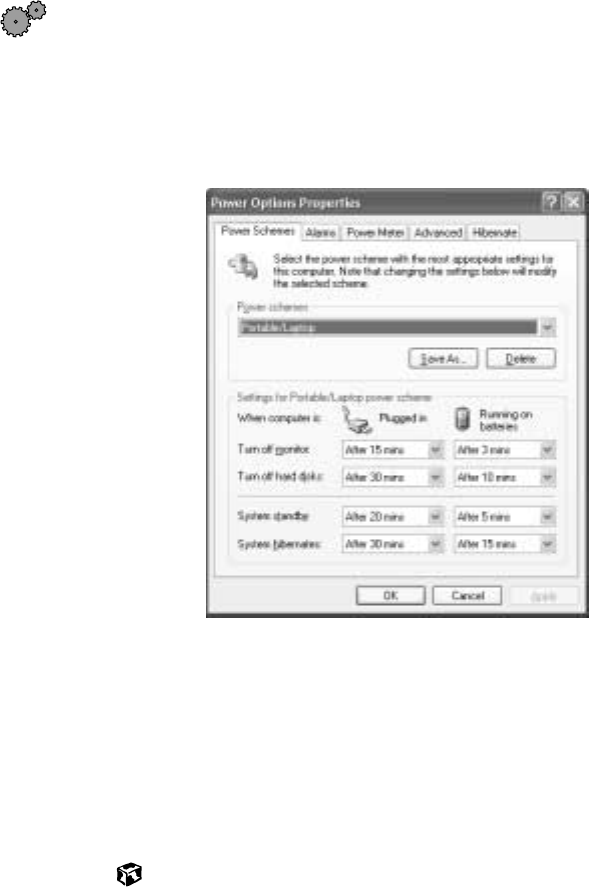
108
Chapter 8: Managing Power
www.gateway.com
Changing the power scheme
To change the power scheme
1Click Start, then click Control Panel. The Control Panel window opens. If
your Control Panel is in Category View, click Performance and Maintenance.
2Click/Double-click the Power Options icon. The Power Options Properties
dialog box opens.
3Click the arrow button to open the Power Scheme list, then click the
power scheme you want.
- OR -
Set the timers, then save your custom power scheme by clicking Save As
and typing a name for the scheme.
4Click OK.
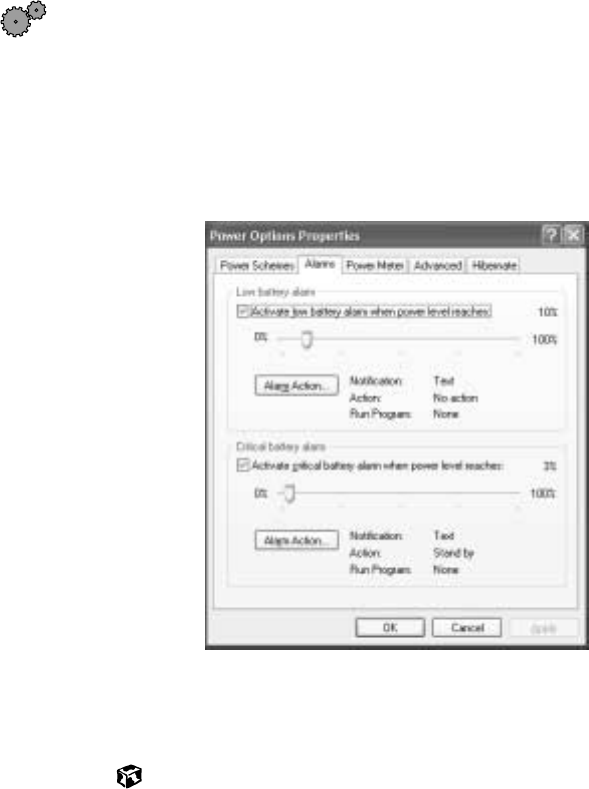
109
Changing power settings
www.gateway.com
Changing alarm options
To change the alarm options:
1Click Start, then click Control Panel. The Control Panel window opens. If
your Control Panel is in Category View, click Performance and Maintenance.
2Click/Double-click the Power Options icon. The Power Options Properties
dialog box opens.
3Click the Alarms tab.
4Adjust the alarm settings.
5Click OK.
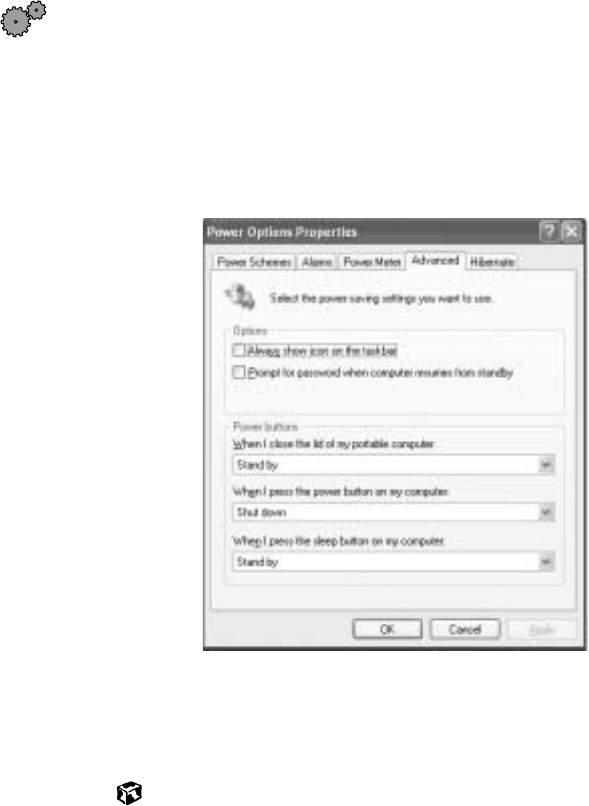
110
Chapter 8: Managing Power
www.gateway.com
Changing advanced settings
To change advanced power management settings:
1Click Start, then click Control Panel. The Control Panel window opens. If
your Control Panel is in Category View, click Performance and Maintenance.
2Click/Double-click the Power Options icon. The Power Options Properties
dialog box opens.
3Click the Advanced tab.
4Click the arrow button to open a Power buttons list, then click the power
setting mode you want to use.
5Click OK.